Plan the perfect Puglia itinerary | essential Puglia day trip and road trip guide.
We don’t all travel equally. Some travel solo, in couples or groups, with families, and with different expectations and aspirations. That’s why we don’t think there’s a “one size fits all” Puglia itinerary for visitors. We take a different approach.
Instead of suggesting prescriptive routes, we break Puglia (and Matera our near neighbour in Italy’s Basilicata region) down to its essential parts so you can plan your own perfect Puglia itinerary. Combine destinations to suit your travel style and circumstances. Whether you’re here for a quick getaway or a slow immersive experience. For efficient day-tripping, making the most economic use of time and distance, or packing in as much of our region as you can during a shorter stay.
Here we consider visiting these destinations as day trips, when your chosen base is elsewhere. While we deconstruct Puglia, keep in mind that we embrace a slower pace of life. Il Dolce far niente. It is part of our culture, reflected in all aspects of life and daily rituals. Keep this in mind when planning your Puglia itinerary, for a more mindful and restful stay in Puglia’s here and now.
We also suggest our favourite Puglia road trips to bring some destinations together.
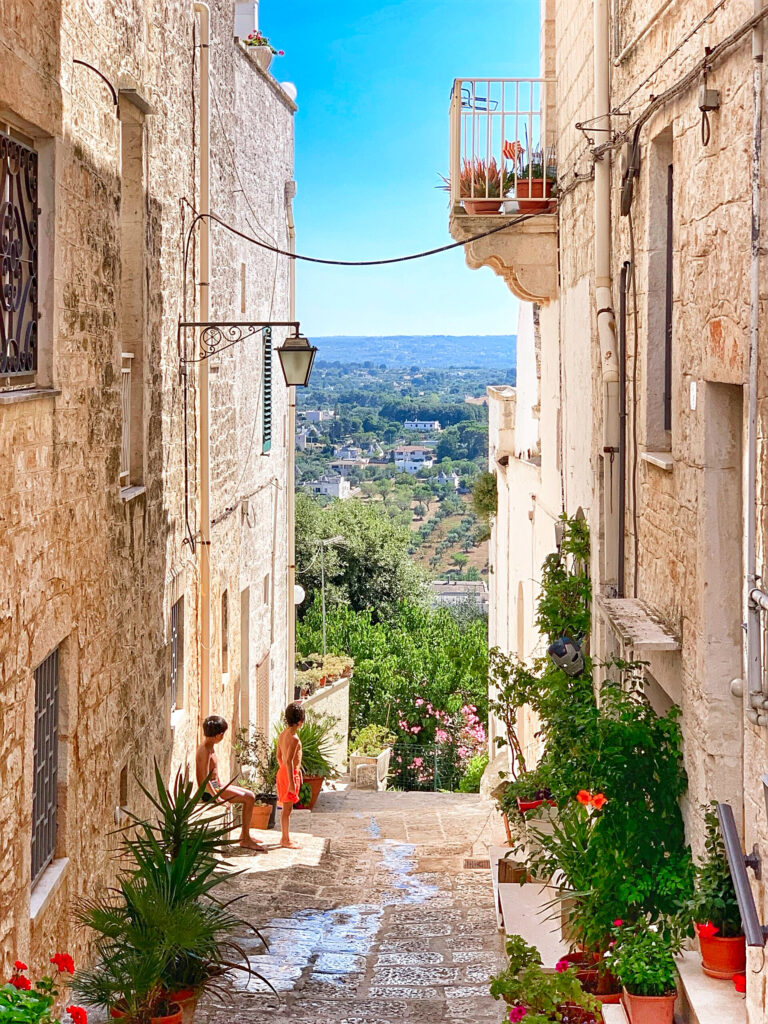
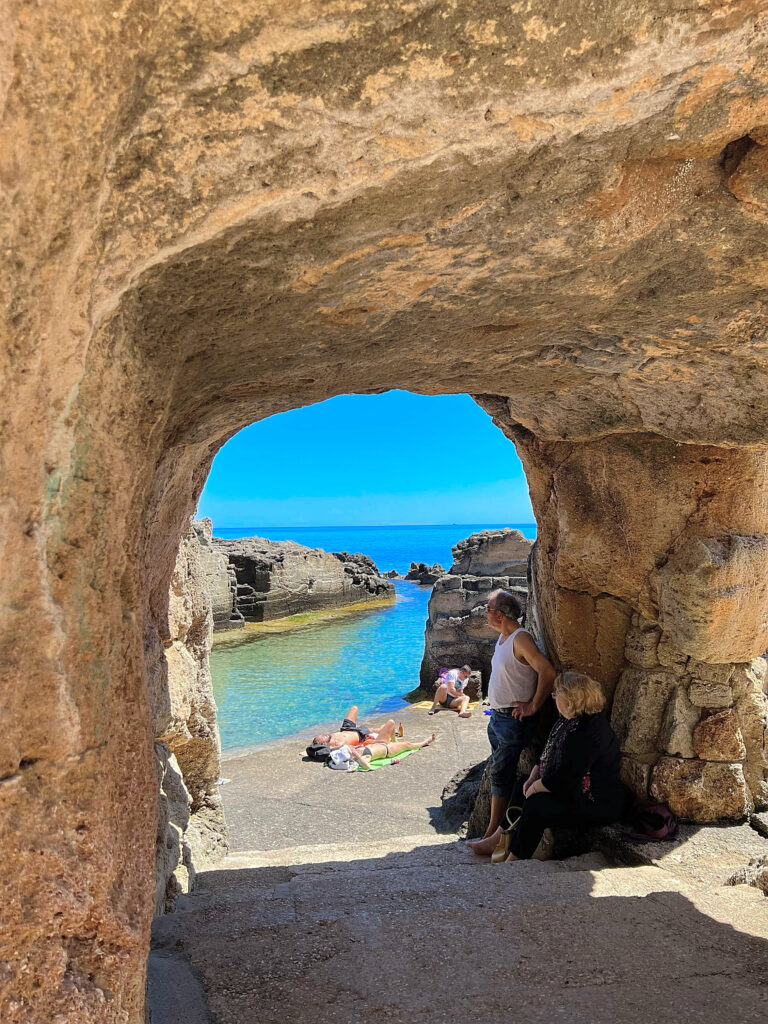
We don’t accept payments or freebies for positive coverage or recommendations. Our reviews are anonymous to ensure we have the same experience as any visitor.
Follow us on Instagram for frequent video stories, reels, photos, ideas and other information to inspire your visit to Puglia.
The Puglia Podcast
Also available on Apple Podcasts, Spotify or wherever you get your podcasts from.
In this guide:
- Plan the perfect Puglia itinerary | Orientation
- Plan the perfect Puglia itinerary | Architecture
- Plan the perfect Puglia itinerary | Food
- Bitesize Puglia
- Plan the perfect Puglia itinerary | Puglia Road Trips
- Plan the perfect Puglia itinerary | Boat trips
- Plan the perfect Puglia itinerary | Walking trips
- Our latest blog posts
Plan the perfect Puglia itinerary | Orientation
Our region, known as la terra tra due mari – the land between two seas – sandwiched between the Adriatic to the east and the Ionian to the west.
From Gargano, a mountainous and verdant peninsula comprising the spur of Italy’s boot, where dramatic limestone cliffs plunge into the deep blue of the Adriatic, to Santa Maria di Leuca at the tip of the heel of Italy’s boot and land’s end, Santa Maria de Finibus Terrae. The 400km in between comprises one of the most diverse regions in Italy.
The expansive Tavoliere, a plain adorned with durum wheat fields around Foggia, transitions southward into the rolling olive groves of the Valle d’Itria, the sprawling vineyards around Manduria, and the prickly pear-lined vistas of the Salento peninsula.
Plan the perfect Puglia itinerary | Architecture
Discover Puglia’s iconic trulli. Cone-shaped dwellings unique to our region. Ancient masserie, once fortified farmhouses to resist bandits and Saracen invaders, now transform into luxurious boutique hotels.
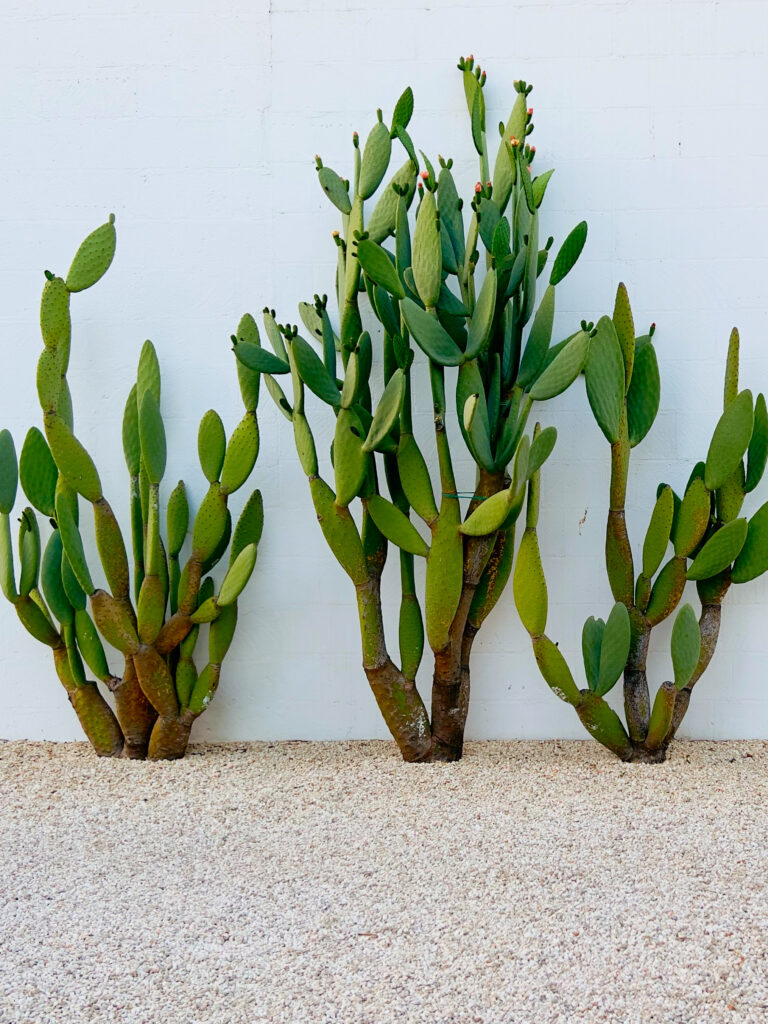
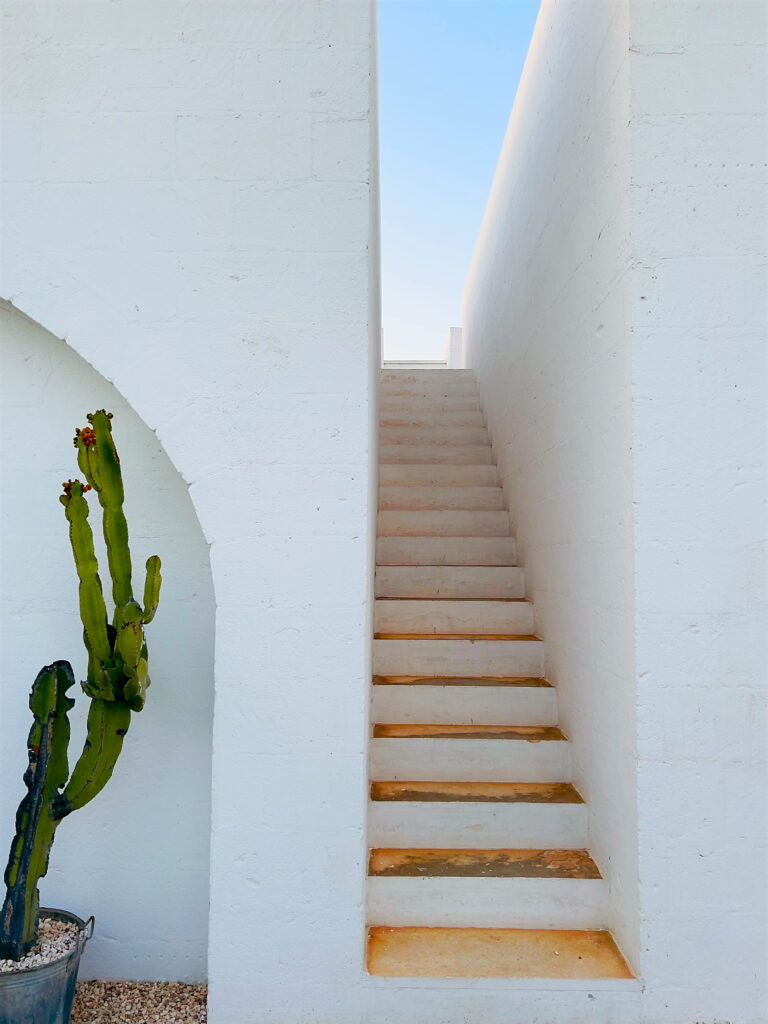
Visit Puglia’s famous città bianche. White-walled towns sitting atop hillsides whose historic centers, a maze of whitewashed alleys, wind around their impressive cathedrals. It is no coincidence that these towns are reminiscent of Greece. The Salento peninsula was once Magna Grecia, greater Greece. In Taranto’s borgo antico, the remains of a Spartan temple stand proud. Throughout Salento, many towns still carry their Greek names. Local dialects betray Greek origins.
Plan the perfect Puglia itinerary | Food
Puglia is the breadbasket of Italy. Our region’s fertile red soil and climate make Puglia one of Italy’s top durum wheat producers. We are the top producer of Italian olive oil, with some of Italy’s best-tasting and most prized oil. We are Italy’s 2nd top regional wine producer. And Puglia gave the world burrata… Why not plan a foodie Puglia itinerary?
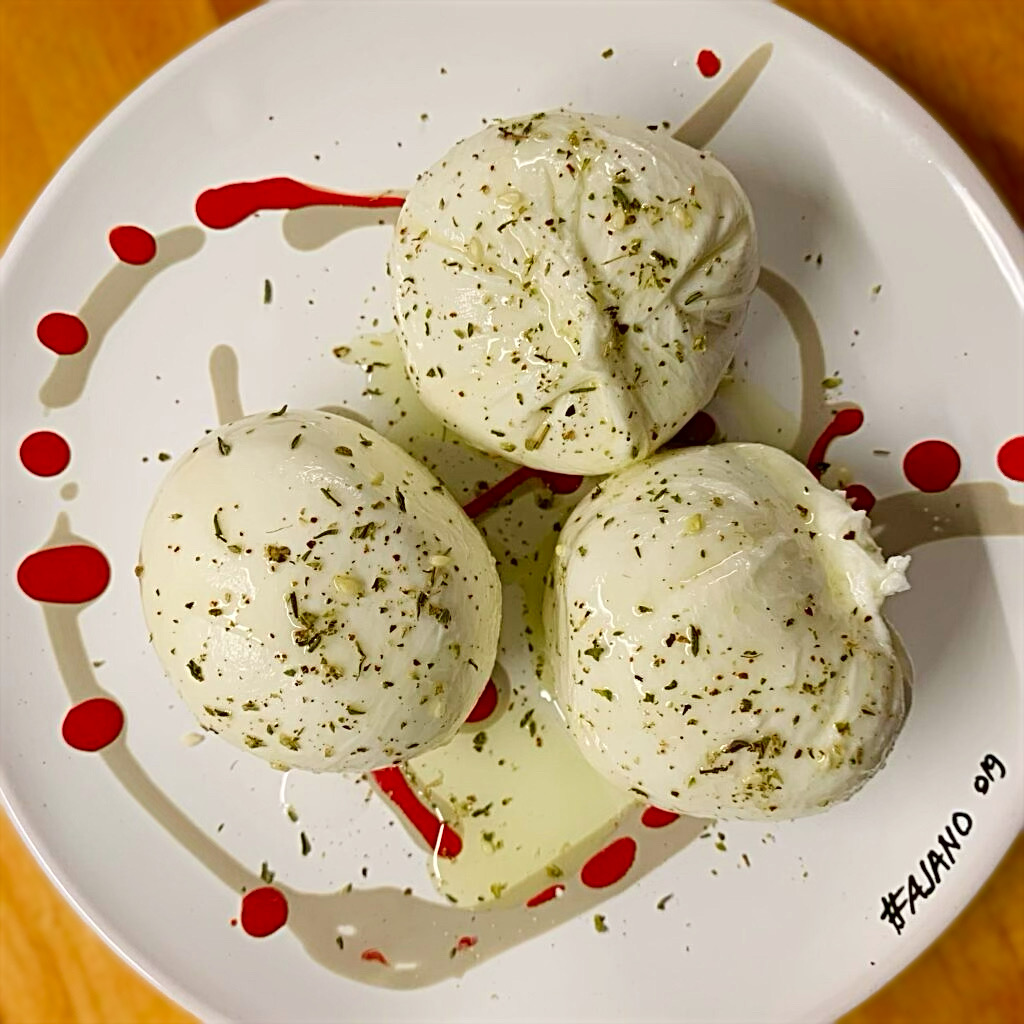
Slow-food is not a gimmick. It’s a tradition. La cucina povera (literally poor cuisine) serves up simple but inventive dishes using seasonal, locally produced, fresh and flavorful ingredients. Most dishes use only a few ingredients and very little goes to waste. Humble and frugal, the end result is much more than the sum of its ingredients.
Wherever you are in Puglia, good food is easy to find. There are fine dining options, but some of the best meals we eat are at a local trattoria or osteria. Simple, delicious, and inexpensive.
In the guides below we make some #EatPuglia suggestions. However check out our individual city guides for the relevant destination or our main Eat Puglia Guide to Puglia’s best restaurants for more recommendations to include in your Puglia itinerary.
Bitesize Puglia
Suggesting you spend no more than two hours in Alberobello does not mean it only deserves two hours. But if you have a shorter stay in our region or want to spend more time on the beach, you can move onto the next destination without feeling you have missed out on Puglia’s iconic standards.
These are suggestions. You can spend more or less time, and you can swap a morning visit ending with a lazy lunch for an afternoon visit starting with lunch. But bear in mind la pausa. The time from around 1pm – 4.30/5pm when we retreat to the shade or head off to dip a toe in the pool. Many restaurants finish their lunch service around 2.30pm, with shops and businesses closed during the afternoon break (especially in smaller towns).
Bari
A half-day is sufficient to explore wonderful Bari Vecchia with its confusing orientation. Staying a night or two there will do justice to the great cuisine available.
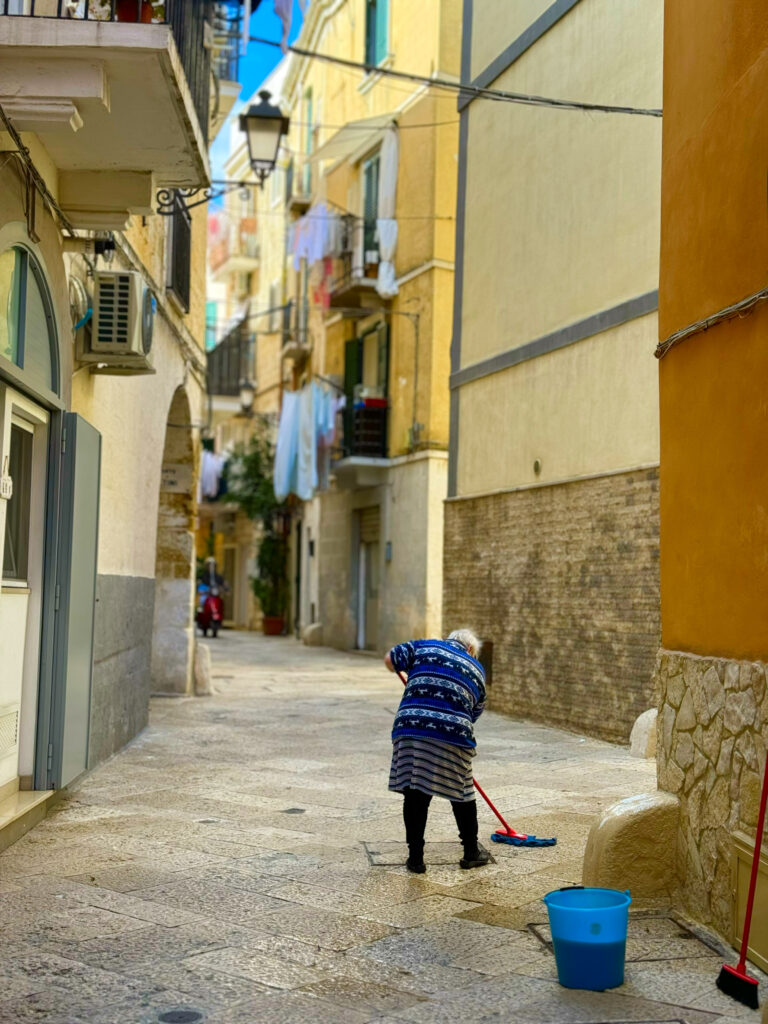
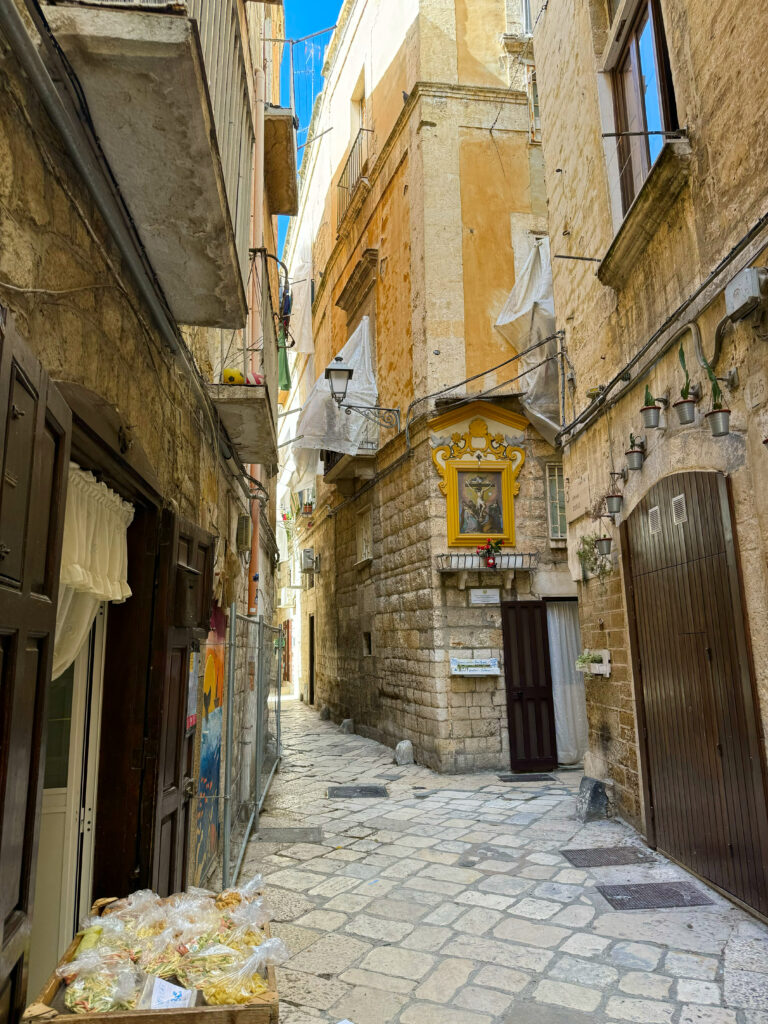
Arrive in time for an early lunch (12.30pm is not too early). For a snack before or after lunch some focaccia barese is essential. We recommend Panificio Fiore. There might be a long line, but service is quick. They have been baking since 1508, so what’s a 5-minute wait? For an even longer line head to Panificio Santa Rita, Bari’s busiest bakery!
After lunch pass through the courtyard of the Basilica San Nicola to the other side of the old town for a coffee in one of the local bars and change of scenery.
Stroll down the Strada delle Orecchiette (via dell’Arco Basso) where you can watch the ladies of Barivecchia make and sell fresh pasta outside their front doors. The easiest way to find it is to head to the Castello Svevo on the edge of the old town, near the main port and the basilica.
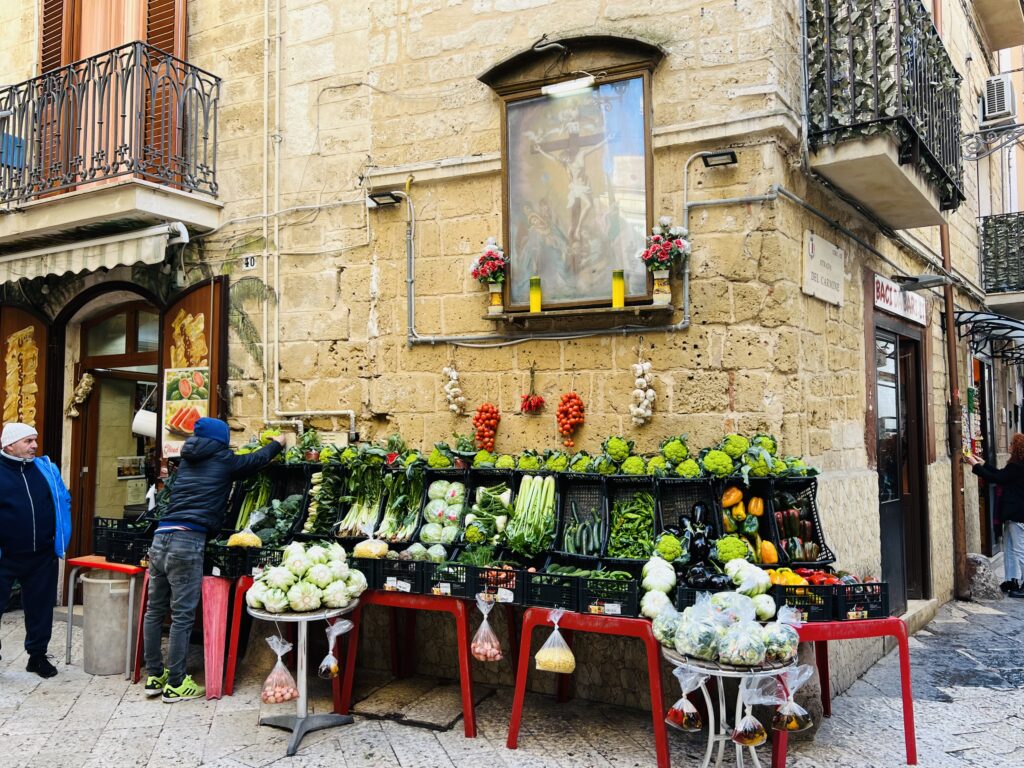
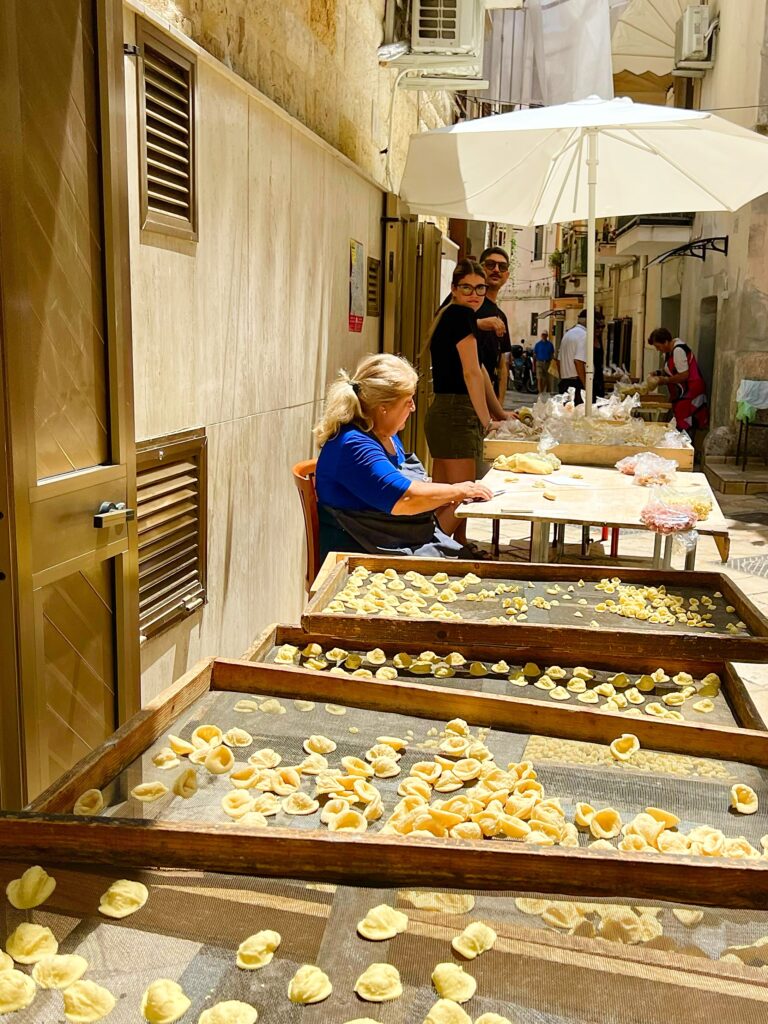
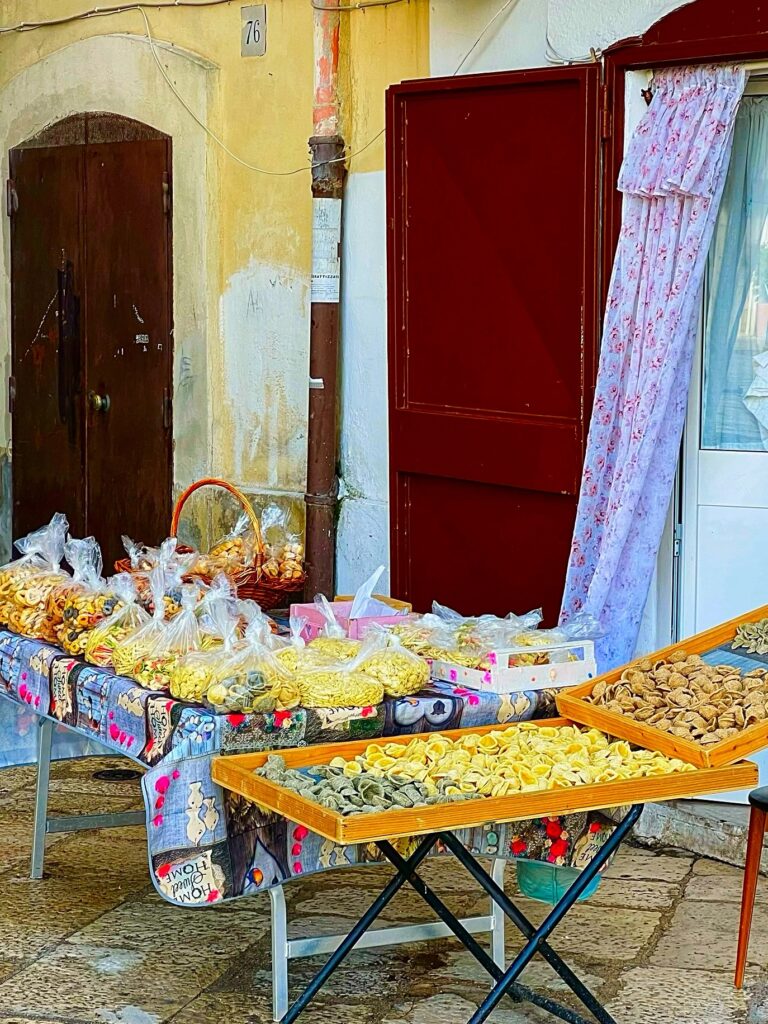
En route you can stop-off for some fried polenta fritters from Le Sgagliozze di Donna Carmela on the picturesque Largo Albicocca, or enjoy Bari’s best gelato at Gelateria Gentile.
If you have not done so already, pass through Piazza Mercantile and Piazza del Ferrarese. Puglia Design Store is worth a visit for quality Made in Puglia ceramic and other non-food products. Then head across the road to the Porto Vecchio fisherman’s market on Molo San Nicola where Bari’s fishermen sell their daily catch. You can buy a plate of fresh seafood with a hunk of break and slice of lemon for 5€ if you get there by mid-morning. In the afternoon and early evening, grab a panzerotto and ice cold Peroni beer for under 4€ (for both) from the legendary El Chiringuito.
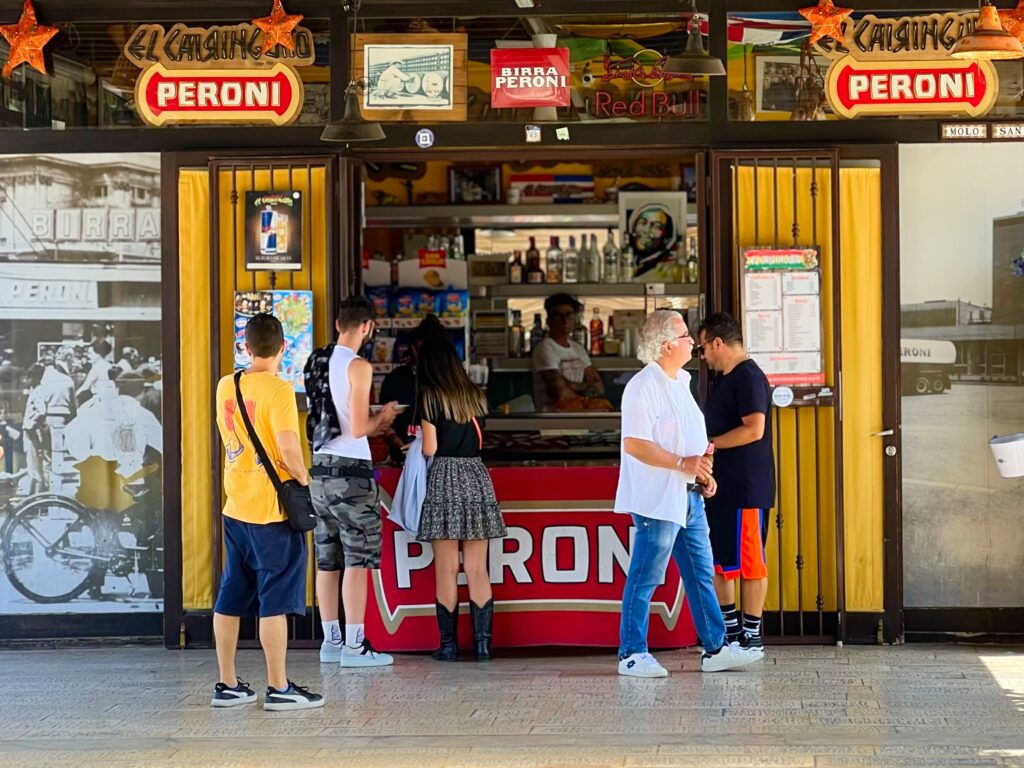
If you want spaghetti all’assassina for lunch we recommend Al Sorso Preferito, which is just outside Barivecchia on the other side of the old port (many of the old town restaurants only serve all’assassina for dinner). But if you are staying for dinner we recommend you have it at La Locanda dell’Elfo, a local favourite. If it’s not on the menu, just ask!
As a base, you can make easy day trips by car from Bari to Matera (50 mins), Alberobello (50 mins), Monopoli (40 mins) and Polignano a Mare (35 mins). Ostuni is further and takes about 1 hour.
Extra toppings | If you have more time, or would like to make more time, the Puglia Guys recommend taking part in the Free Walking Tour Bari around the old town (called “The First”). The tour is led by a qualified, local guide. At a little under 3km it takes just over 2 hours, and is in English (there is a separate Italian tour as well, as also a separate “The Jungle” tour). At the end of the tour you are invited to pay what you want.
Parking | We always try and park at Molo San Nicola by El Chiringuito. It’s pay parking, and you input your car licence plate (registration) number – so remember to have it handy before the machine! We drive into Bari usually from the south and we come off the Adriatic Highway just as it becomes the Bari tangenziale, for an easy and picturesque drive along the lungomare all the way into the centre of Bari.
More | eat like a local in Bari with the Puglia Guys guide to Bari’s best restaurants | the story of Bari’s must-eat dish, spaghetti all’assassina and the Puglia Guys assassin’s trail for the best all’assassina in Bari | our Bari city guide.
Matera
Take a full day to explore the city of the Sassi in the neighbouring region of Basilicata.
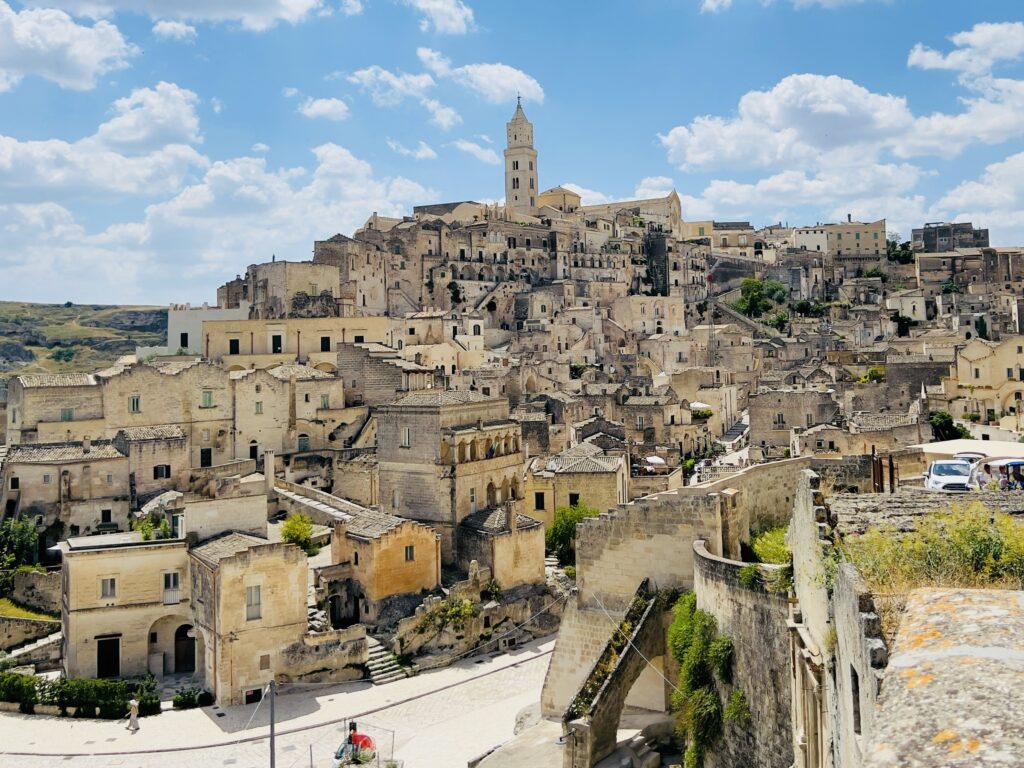
The trick is navigating the winding alleys and ways and managing the levels as you descend. A wrong turn can take you in a different direction and, although you’ll still come to Via Madonna delle Virtù, eventually, you might end up with an unexpected longer walk. Good luck with GPS – in the warren of Matera’s multi-level alleys it confuses the heck out of us!
We suggest a route covering many of the major sites and attractions in the Sassi of Matera. It can be completed in about 2-3 hours depending on how much time you spend at each location. Note that the streets in the Sassi can be steep and uneven, so be sure to wear comfortable shoes. Bring water and sunscreen.
Keep in mind 4 key locations, for four parts of the journey:
- Piazza Vittorio Veneto (1) to the Piazza Duomo (2) for the Basilica (gentle climb, steeper towards the Duomo).
- Piazza Duomo (2) to Piazza San Pietro Caveoso (3) (incline down).
- Piazza San Pietro Caveoso (3) to Piazza Pascoli (4) (uphill).
- Piazza Pascoli (4) back to Piazza Vittorio Veneto (1) (level-ish).
The rest you can work out between and around them. You don’t need to start at Piazza Vittorio Veneto. We have suggested the main square because of its proximity to the train station (and parking areas). You can start anywhere, and in either direction. If you are staying in the Sassi it might make sense to start at Piazza San Pietro Caveoso and walk up.
On our last visit we visited Casa Grotta nei Sassi di Matera for a fascinating guided visit of life in the sassi and in Matera. The 5€ ticket for adults is well worth it. The audio guide (included in the price) is accessed via your smartphone.
Not to be missed is the gelateria: I Vizi degli Angeli – Gelateria Artigianale. Even better if the lavender ice-cream is in season. If not don’t worry, the flavours are delicious and the ice-lollies are top. Especially the Aperol Spritz flavoured lolly.
Extra toppings | Matera’s city festival happens on 2nd July – if you happen to be there, you will be amazed at the ritual of destroying the procession float. The tradition derives from Saracen occupation when Christianity was prohibited. Rather than have their icons and religious statues destroyed by the invaders, locals thought it was kinder to destroy them themselves. Thus crowds rush and surge to destroy the float at the end of the precession. It’s rather chaotic, and confusing if you don’t know of the tradition.
Parking | We usually head towards Matera Centrale Railway Station for parking. Around here, the parking spaces in the blue lines have a number. Remember that number. You need to input it in the ticket machine (as well as the car licence plate (registration) number. From there it is a very easy walk down Via Don Giovanni Minzoni and Via Ascanio Persio to Piazza Vittorio Veneto where you can get your bearings.
More | discover Matera with the Puglia Guys Matera city guide.
Polignano a Mare
Two to three hours includes eating time without swimming. Allow a half day to include bathing.
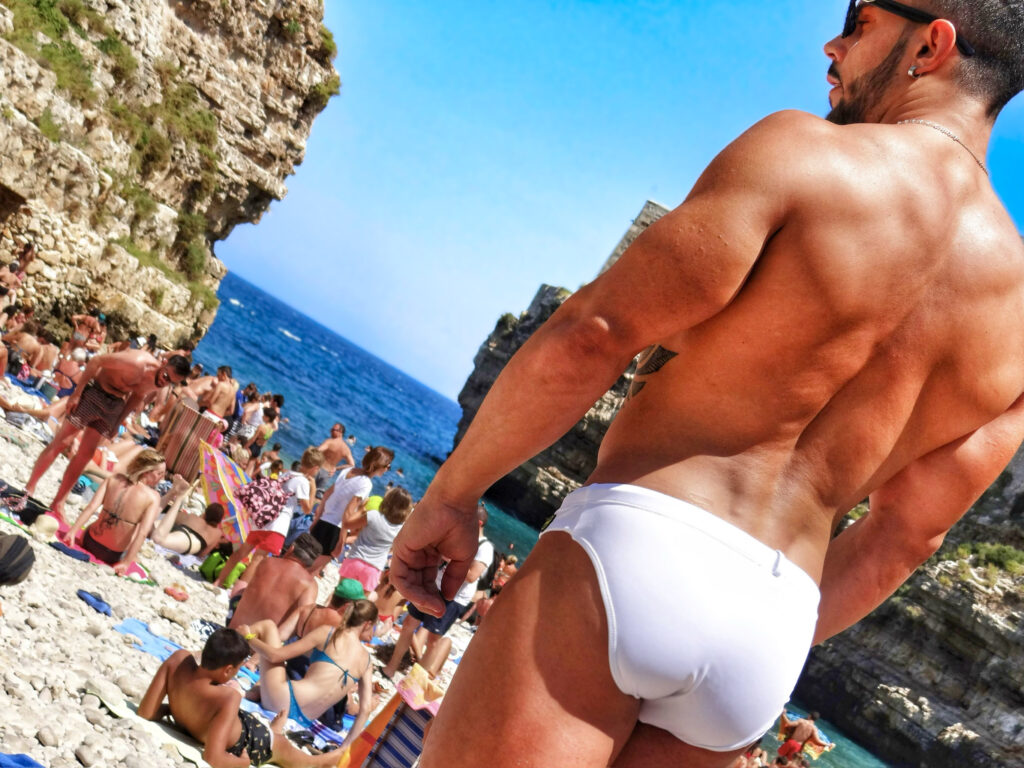
The iconic pebble beach at Lama Monachile is uncomfortable to sit on for any length of time, even with the thickest beach towel. But nothing beats the experience of swimming out between the cliffs and inside the cave under the old town.
From our Ostuni base it makes perfect sense to do Alberobello (40 minutes) in the morning, Monopoli (25 minutes from Alberobello) for lunch then Polignano (10 minutes from Monopoli) for gelato and a special coffee. This configuration works for us because it’s a very picturesque drive across the Valle d’Itria through Cisternino (20 minutes from Ostuni) and around Locorotondo (10 minutes from Cisternino) to Alberobello (10 minutes from Locorotondo), then onward to Monopoli.
From Polignano we head home to Ostuni (40 minutes) along the Adriatic highway.
Do it in reverse for a swim before lunch.
Likewise from Bari, you could combine the same destinations in one day, again heading first to Alberobello.
The key views of Polignano are from Ponte Borbonico su Lama Monachile (the bridge down over the beach), Belvedere Terrazza su Lama Monachile (the terrace that looks onto the beach from the old town end) and Belvedere Terrazza Santo Stefano (Terrazza Santo Stefano, out to the Adriatic from the old town).
Take the steps (on the other side of the bridge) down to the seafront. Even better, the experience of swimming there. But not for the tender-soled. It doesn’t have sharp rocks or sea urchins, but those pebbles are uncomfortable!
If you choose to eat lunch in Polignano, head to the popular Pescaria | Piazza Aldo Moro, 6/8 (try to get there before 12.30pm or after 2.30pm to avoid a long queue).
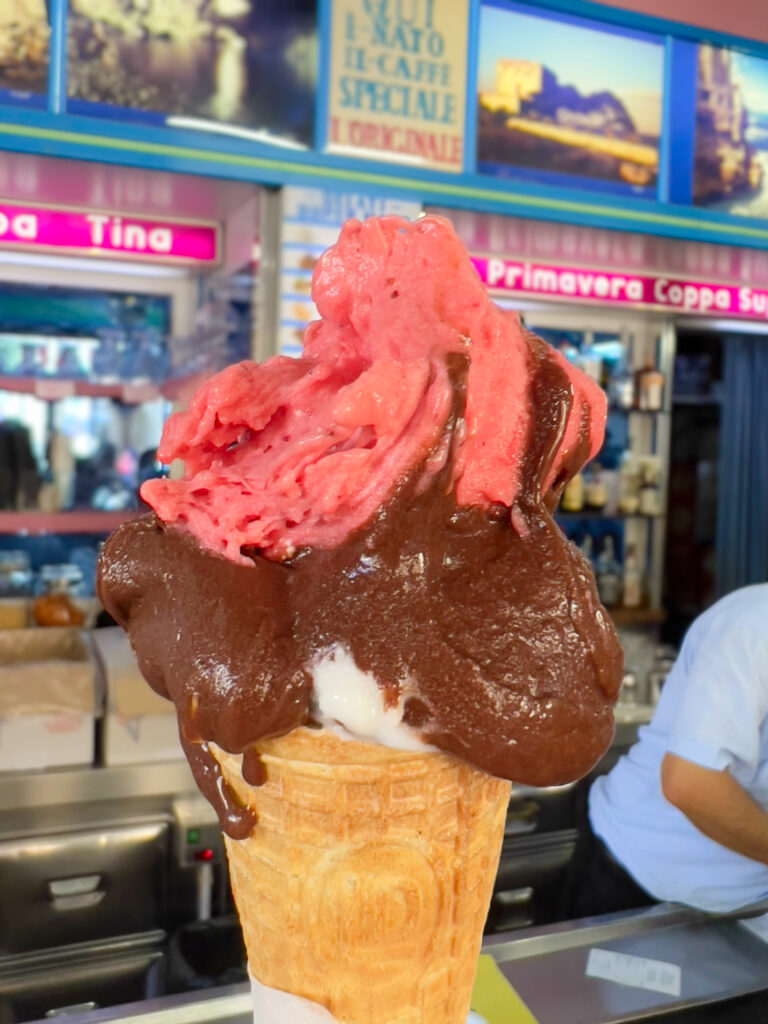
For gelato and coffee after lunch head to Mario Campanella “Il Super Mago del Gelo” | Piazza Garibaldi, 22. The special coffee is amazing.
Parking | We try to park around Piazza Aldo Moro (pay parking). Often it is full, in which case head up towards the railway station. We usually find a parking space on the way.
More | the Puglia Guys city guide to Polignano a Mare – eat, swim, walk and shop.
Monopoli
Two to four hours, including lunch.
Eat at or around the lively Piazza Giuseppe Garibaldi. We like La Dolce Vita Ristorante.
Follow this with a walk along the porto antico to the Castello Carlo V, then follow lungomare along the defensive sea wall. After the Bastione Santa Maria walk down the steps and along the seafront (asking the Bastione di Babula) to Spiaggia Cala Porta Vecchia, which will take you back into the compact old town if you hear right. Turn left for more seafront.
Parking | We try and park around Piazza Vittorio Emanuele II and walk to the old town from there. Blue lines mean pay parking, white lines mean free parking (but check there are no maximum time limits imposed on free parking). From the south we often drive directly to the city beaches and park at Parcheggio Pentima.
More | our Monopoli city guide.
Alberobello
Two hours to soak up all that is Alberobello.
Unprepared for the crowds and the commercialisation of Alberobello many visitors we speak to leave feeling underwhelmed – and sometimes even unimpressed. The authenticity and charm of a long gone way of life has all but evaporated.
Yet no trip to Puglia would be complete without visiting the trulli of Alberobello.
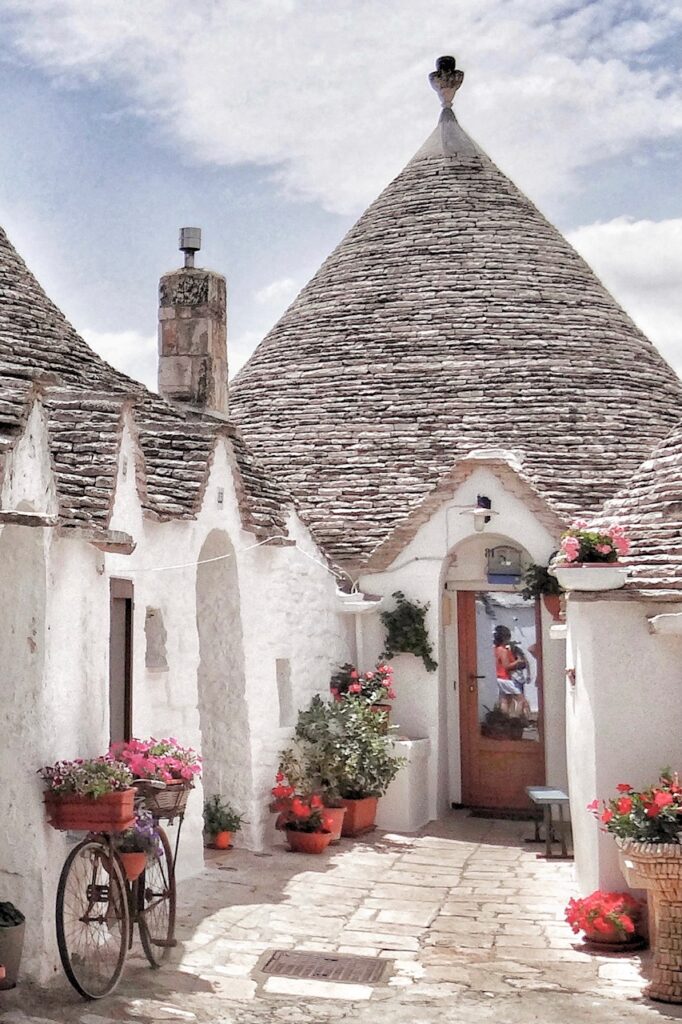
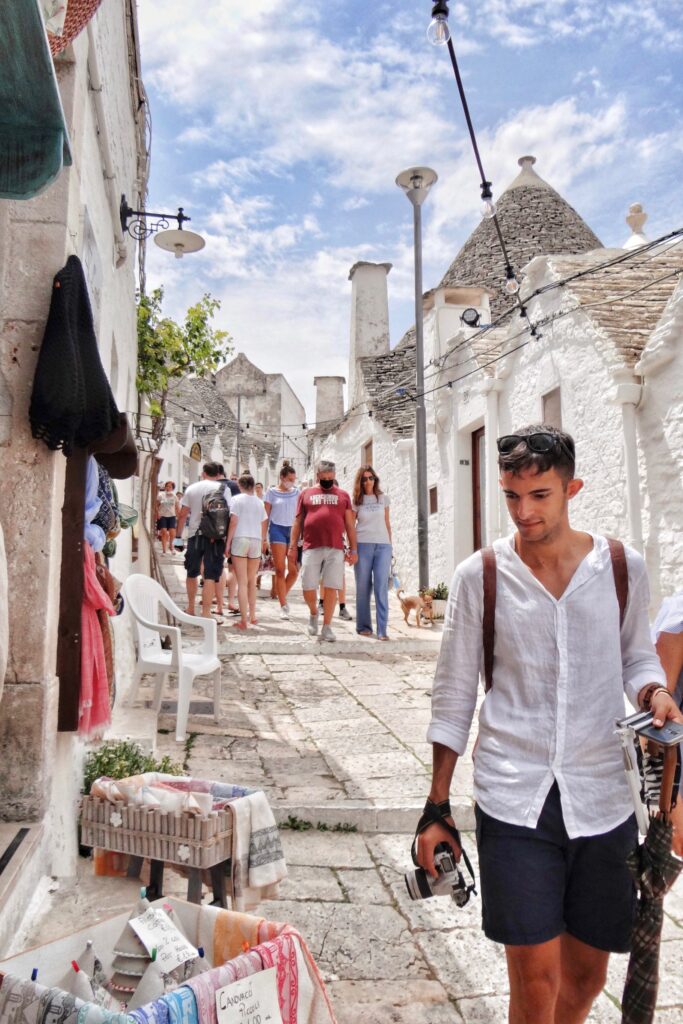
Most tourist guides and commentators suggest arriving early to avoid the organised tour groups as Alberobello fills up by the bus load. To some extent trying to avoid negotiating the crowds is impossible, even by arriving early in the morning as more people take that advice on board. Besides, that is now part of the Alberobello experience.
Arrive when best suits you. Mid-morning (or late afternoon – after 5pm) works for us.
Rione Monti the over-commercial main trulli district should not be ignored. Although it is the heart of the trulli zone, it is no longer the soul. No need to amble – save that for later. Walk up Monte S. Michele, grab a coffee and delicious pastry at Martinucci Laboratory, via Monte S. Michele, 57. Cross over to Monte S. Gabriele and then onto Monte S. Marco.
Job done. You have seen what most visitors come to Alberobello to see.
Now cross over the Largo Martellotta and head up the steps towards Piazza XXVII Maggio and the rione Aia Piccola. The Aia Piccola district is less crowded, its restored trulli – mostly B&B accommodation – with characteristic original stonework intact. If you dig a little deeper you can discover a secret, hidden space offering a more intimate, close-up experience of Alberobello’s heritage.
Rione Aia Piccola | from Piazza XXVII Maggio head to Via Giuseppe Verdi and enjoy wandering around. If you have time take via Verdi all the way to via Colombo where you will see the splendid Villa Tria. Be sure to walk down Via Galileo Galilei and onto Vico il Duca degli Abruzzi. Keep going to discover some unrestored trulli in their original setting with some wonderful views through the pine trees over the white washed cone topped trulli of the rione Monti. In that instant you will find the Alberobello that inspired Pasolini.
Parking | Try the top end of Via Cavour (pay parking in the blue lines). We turn up Via Cairoli and if we are in luck can find a free parking spot (white lines). Again, check for any time limit restrictions on free parking! At the other end try Parcheggio “Nel Verde” pay car park (also for camper vans).
Moreberobello | Love me Trulli – the story of Alberobello’s unique stone dwellings | Trails of the Unexpected: the Puglia Guys guide to Alberobello’s secret spaces | Alberobello city guide.
Locorotondo
Drive by.
Many of Puglia’s white towns have a similar feel, so there is no need to visit them all. Drive around the front of Locorotondo when passing by to Alberobello or Cisternino to see why it takes that name.
Cisternino
For lunch or dinner.
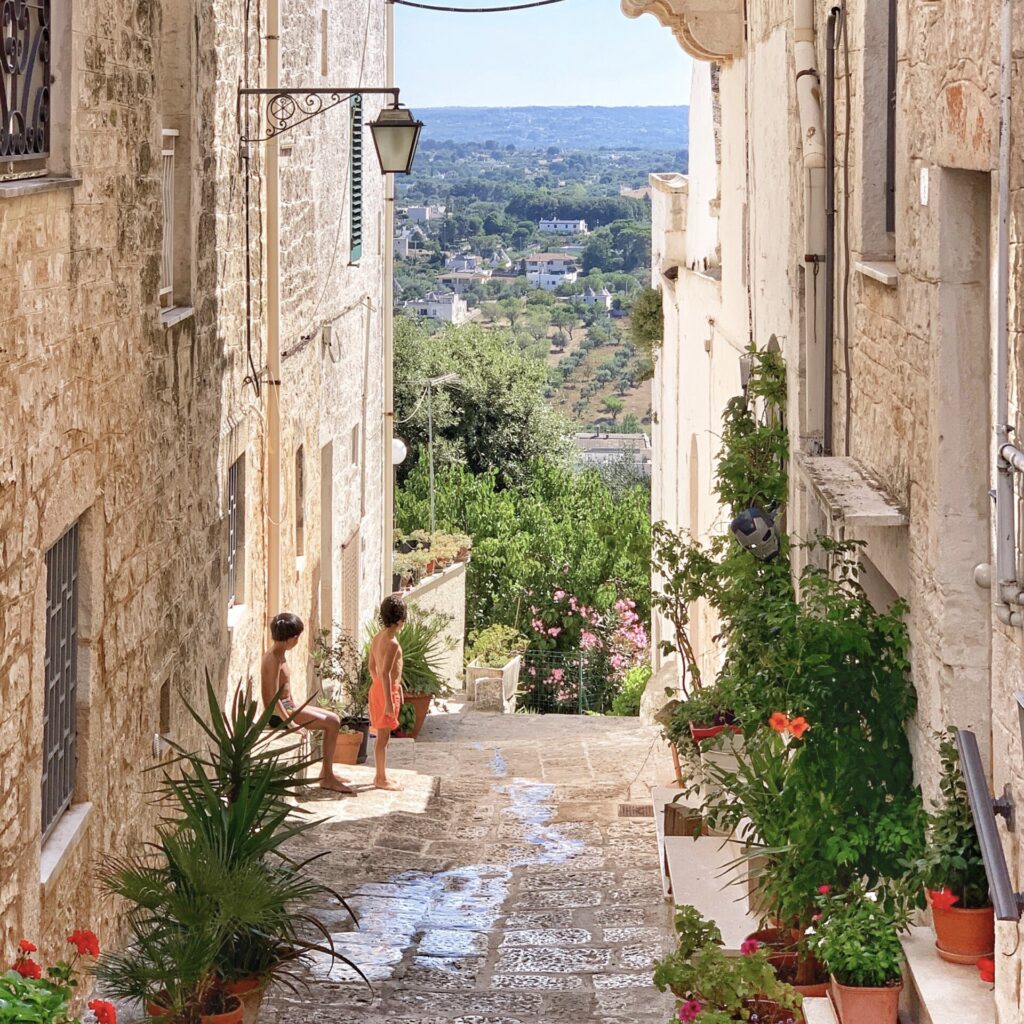
Good for a lunch or dinner at one of its traditional Braceria restaurants for bombette. We like Al Vecchio Fornello.
If you are there during the day grab a post-lunch coffee and gelato (or morning pastry) at Cremeria History Vignola and enjoy the panoramic view.
Parking | Pay parking on the side of the historic centre is available right by Cremeria History Vignola. Continue down Via Principe Amedeo and circuit back round if you had no luck!
Ostuni
Half a day.
Start with lunch at the excellent family run Osteria Ostuni Bistrot on the Piazza della Libertà. The restaurant’s external seating area is right next to the seating area for a restaurant now called Petit Bistrot (it was Pizzeria Codice a Barre). Do not confuse the two. Ostuni Bistrot is where we want to eat at.
Walk up into the centro storico, explore the tangle of streets and head up to the main cathedral. Pass under the Arco Scoppa. Have a gelato at the gelateria on the corner, then walk through the narrow street to the panoramic view over the olive grove, and Ostuni’s most photographed selfie-spot. Not the panoramic view, but la Porta Blu (the house with the blue door, in actual fact a private rental apartment).
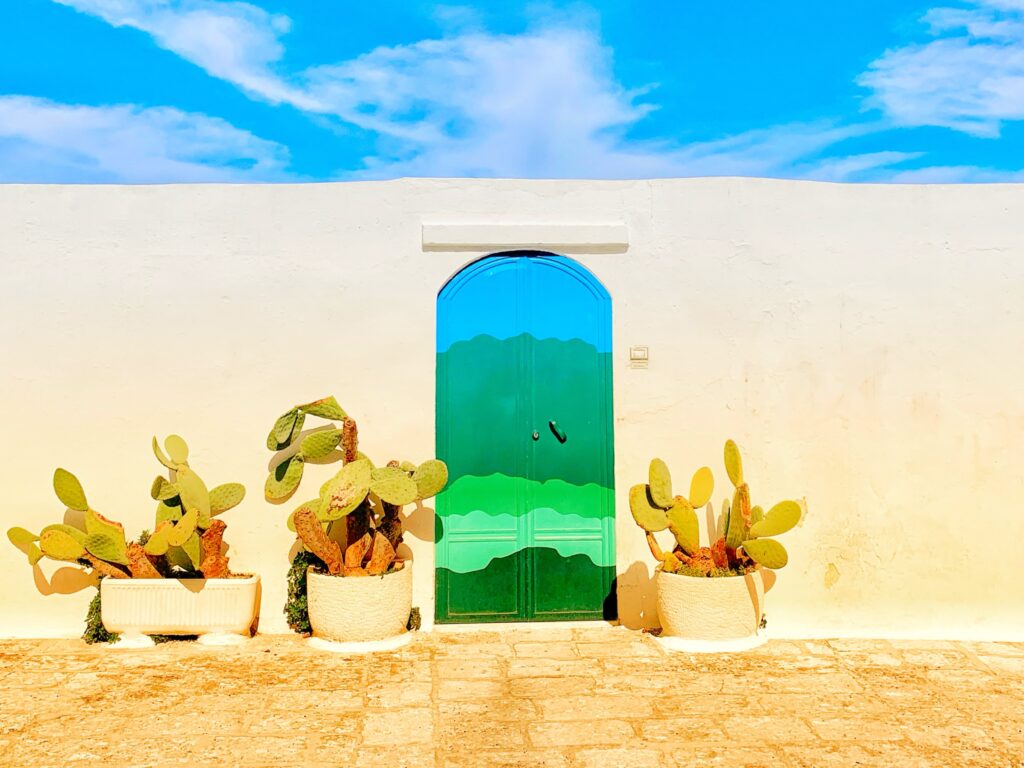
For a table with a view Borgo Antico Bistrot is nice to sit at for an afternoon aperitivo (and it’s reasonably priced especially given the location). Then continue left (and down) walk round the front side of the old town, through the maze of whitewashed alleys, back onto Via Cattedrale and down to the piazza della Libertà . Alternatively at La Porta Blue turn left and walk down to Chiesa Rettoria di Santa Maria della Stella where you can walk along Viale Oronzo Quaranta which is Ostuni’s old town defensive wall.
Places we avoid in Ostuni
Riccardo Caffè – we were overcharged the prices advertised on the menu and, in addition to paying the usual coperta cover charge, each paid an additional charge for “live music” (the DJ). When we pointed out the overcharge we were eventually asked to leave in a manner that was not the friendliest!
Osteria del Tempo Perso – we ate here only once. We don’t need to eat here again. This is a restaurant for tourists, who then recommend it to other tourists. We can eat food that we enjoy more (at prices that are closer to the prices local residents would usually pay) elsewhere in Ostuni!
Casbah Risto Café – chic trendy bar, but to avoid a nasty shock do not sit here and order without first checking the prices. At 15€ a glass this is the most expensive Aperol Spritz on the piazza. Instead sit on the other side of the Sant’Oronzo column at Caffè Fanelli Bistrot where the Aperol Spritz is just under 5€ (and comes with the same trimmings).
More | the Puglia Guys guide to eating out in Ostuni like a local – Ostuni’s best restaurants | our Ostuni city guide.
Ceglie Messapica
Visit for lunch at a family run trattoria with traditional home-style cooking.
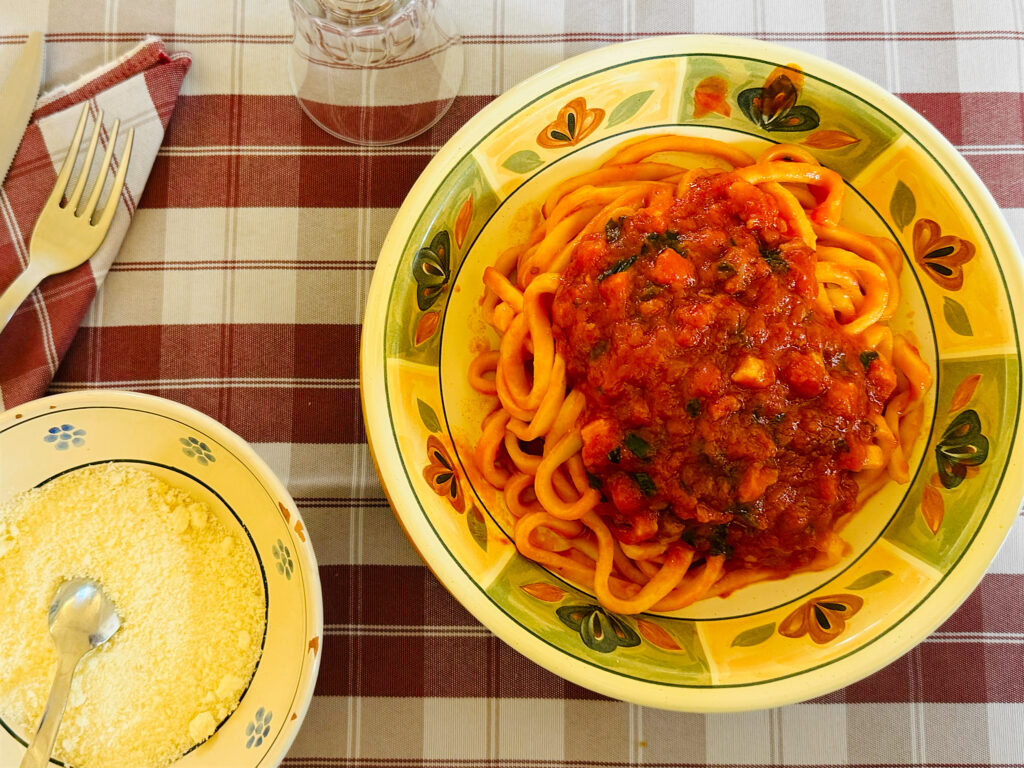
Ceglie has a reputation as a gastronomic destination. See our #EatPuglia guide for specific recommendations.
Carovigno
For aperitivo and dinner.
A worthwhile change of scenery if you are staying in nearby Ostuni. It has a lovely old town with a selection of restaurants that really punch above their weight.
It also has the very lovely and much Instagrammed Picci Bar.
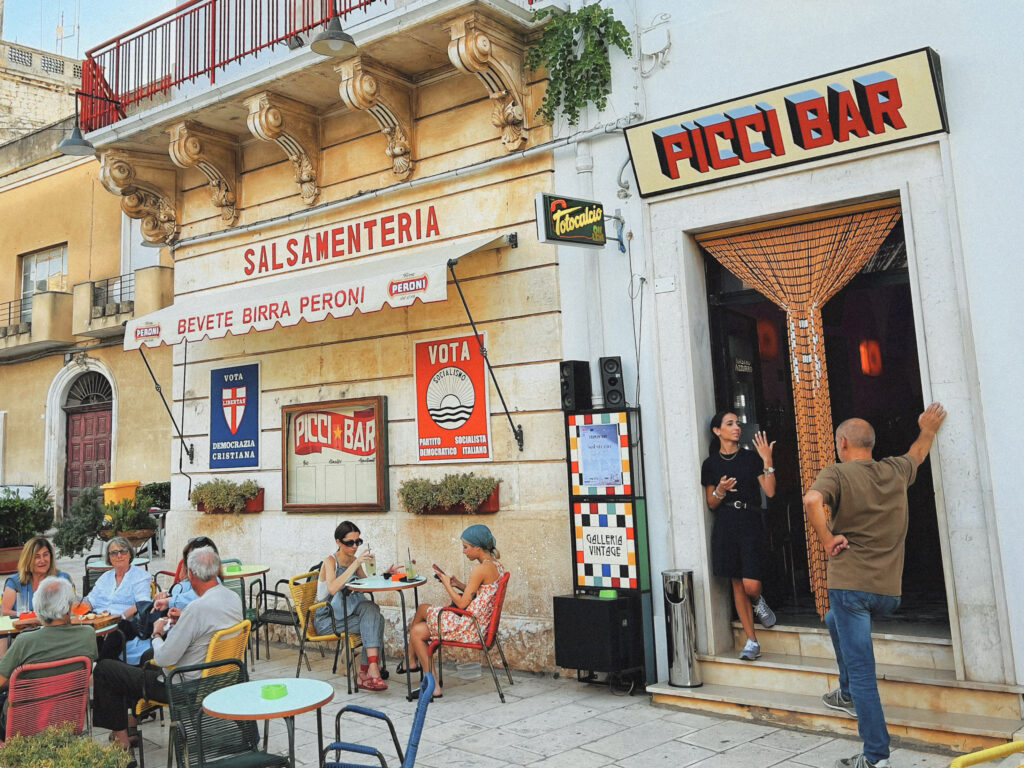
Check out the Puglia Guys Carovigno guide for the best restaurants and bars in Carovigno.
San Vito dei Normanni
For aperitivo, dinner plus an authentic pizzica experience.
Summer nights in Salento have a distinct energy. In contrast to the sleepy stillness of the afternoon, Salento evenings pulse with the rhythm of pizzica music.
San Vito dei Normanni remains at the heart of Salento’s pizzica tradition. Experience the San Vito feeling with a visit to Strato bar for free open air pizzica music and dancing. A popular and lively local haunt for aperitivi, serving up decent bar food. It shares the same location as one of our favourite restaurants xFood if you prefer a restaurant dinner menu instead.
Popular pizzica nights featuring local musicians with street dancing regularly take place (usually on Thursday nights) at Antiko Cocktail Bar. They also serve great bar food.
San Vito dei Normanni is 15km to the south of Ostuni, between Carovigno and Mesagne.
More | the San Vito Feeling – where to take part in pizzica nights in Puglia.
Brindisi
Half day.
Once upon a time when Puglia was the center of the known world, Brindisi was one of the great intersections of the Mediterranean. A major center of Roman naval power and maritime trade, Brindisi was once one of the busiest ports in the world. The Via Appia ended here, the Crusaders set off from here. During WW2 Brindisi was Italy’s capital city for 8 months before the defeat of fascism.
Have lunch and take a walk along the lungomare – Brindisi has a really nice, simple lungomare. It has a couple of interesting museums that show off the history and antiquities. Take a boat taxi to the National Sailor Monument.
The main boulevard Corso Giuseppe Garibaldi leading from the lungomare feels different from Bari and Lecce, lined with palm trees.
Try Betty – Gelateria Cafe Ristorante Pizzeria for morning coffee and pasticciotto or afternoon coffee / post-lunch gelato.
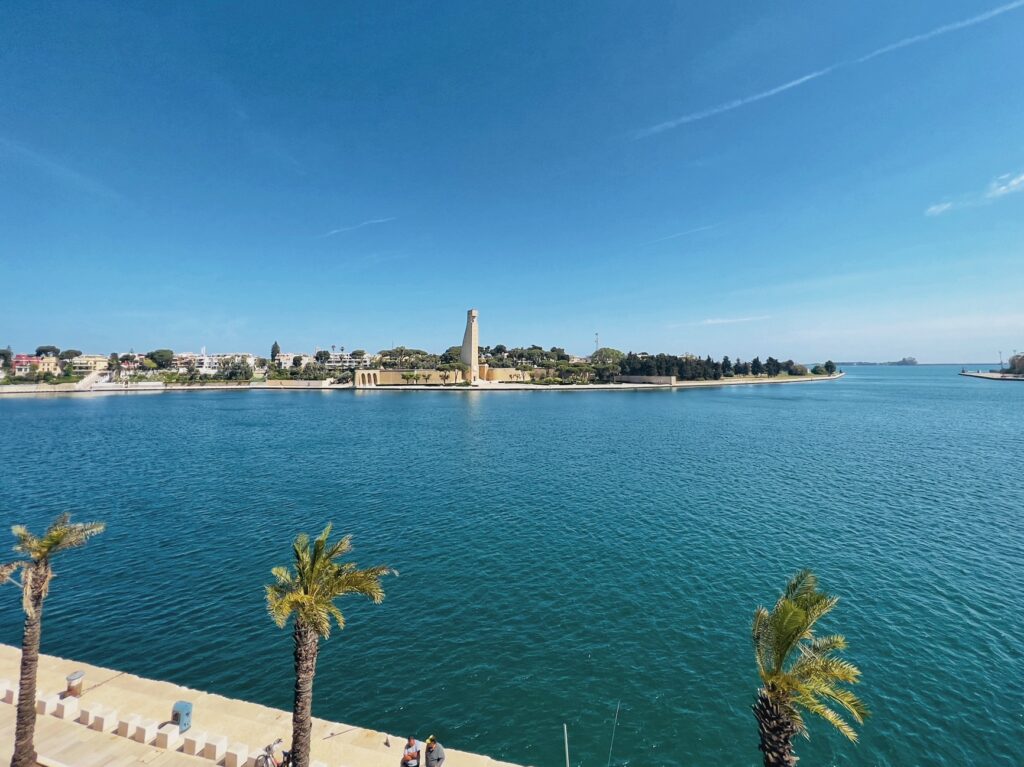
See the Colonne romane di Brindisi, marking the end of the Via Appia. Here once stood Virgil’s home, now marked with a name plate. There is a nice panoramic terrace at the Palazzina del Belvedere – which houses the Collezione Archeologica S. Faldetta.
Museo Archeologico Francesco Ribezzo by the duomo is a fascinating museum, then we usually take lunch at La Locanda del Porto. Or for a lighter lunch (or great evening pizza) continue along the lungomare to the fascist monument the Fontana Vittorio Emanuele III (Fontana Grassi) and walk up to Piazza Santa Teresa for the monument to the fallen soldiers and head to Brunda pizzeria on the pretty little Piazza Dante, a local favourite.
More | the Puglia Guys Brindisi city guide.
Lecce
Take a day to include a late, leccese breakfast and lazy lunch.
Enjoy the typical Lecce breakfast on the main piazza: pasticciotto and a caffè leccese. If you prefer savoury then take a rustico leccese. Walk around the historic centre. The old town, a Baroque maze within walls built by order of Emperor Charles V in the 16th century to protect the city from invading Turks, brims with good restaurants, busy bars, and some of our favorite boutiques.
New for 2024 is the Up! panoramic lift that takes you up the bell tower by the duomo. We haven’t done it yet, but details are included in our Lecce guide.
Continue along Via Vittorio Emanuele II for the Sant’Oronzo Column, a Roman column that was topped with a bronze statue of the city’s patron saint (the same patron saint as Ostuni, although Saint Orontius of Lecce, the first bishop of Lecce, was born in Rudiae, Lecce), and the sunken Roman amphitheater. An exciting project currently underway aims to restore and give access to the amphitheatre.
If you want to find Sant’Oronzo, the municipality building on via Francesco Rubichi currently houses the removed statue.
Continue to the stunning basilica Santa Croce to admire the sonework.
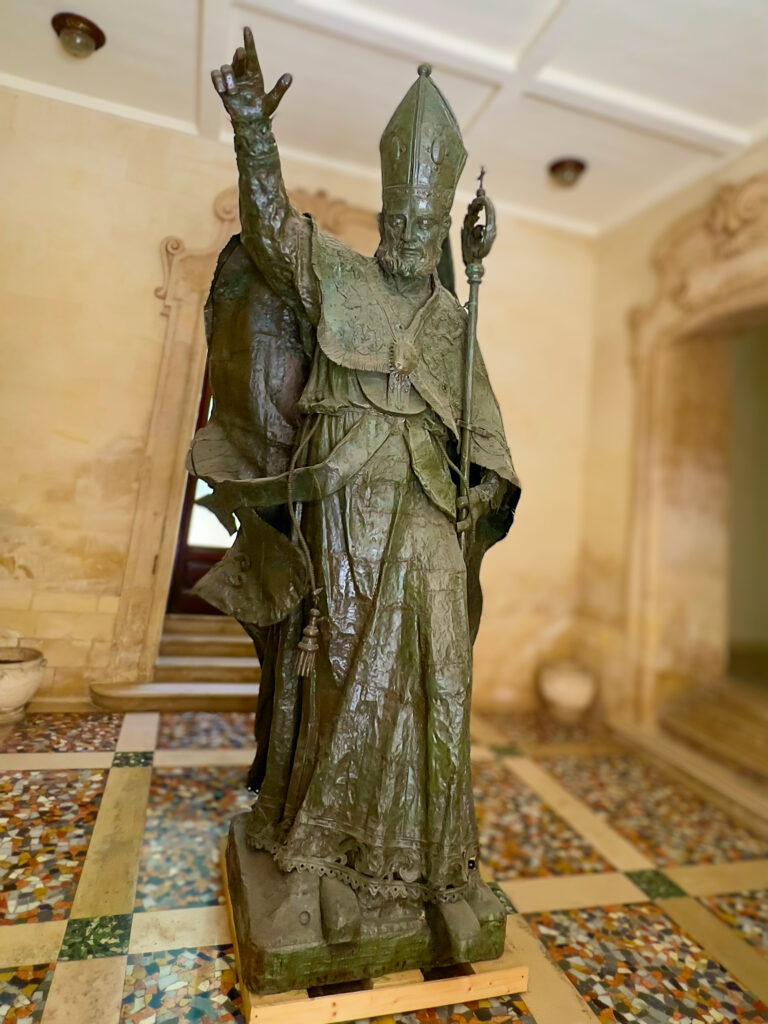
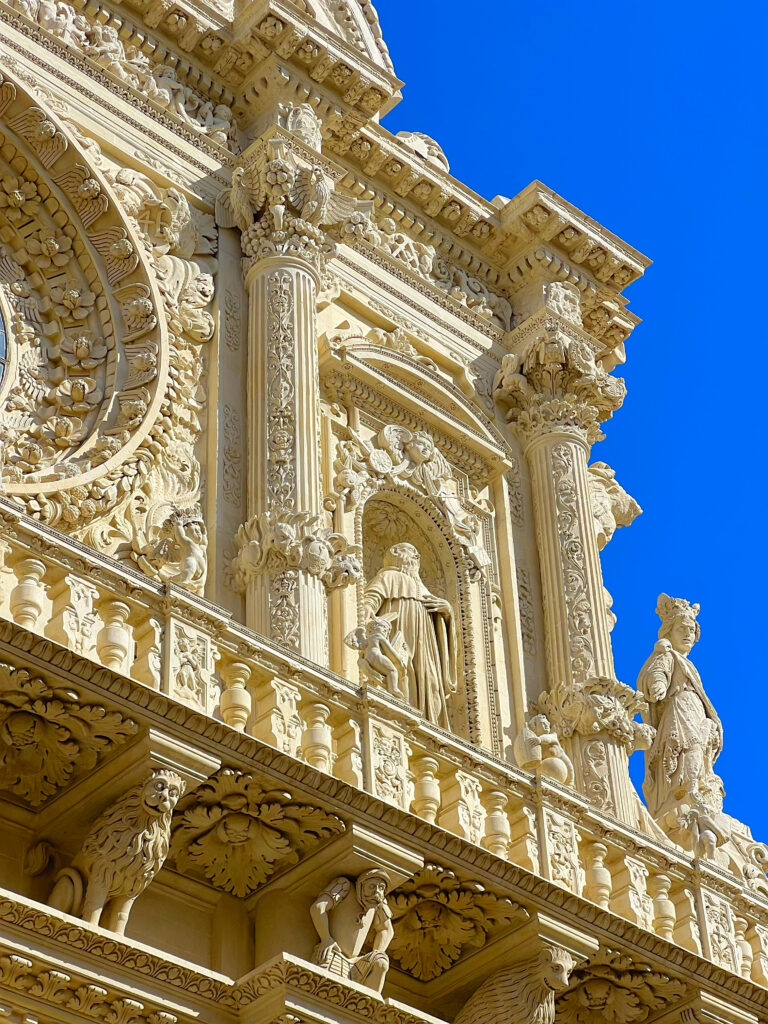
Be sure to stay for lunch. Lecce has so many places we love to eat. We list them in the Puglia Guys Lecce city guide.
Grottaglie and Taranto
It is only a 25-minute drive from Grottaglie’s ceramic quarter to Taranto’s borgo antico. Both are surprising and unexpected parts of Puglia that we totally recommend. They may not technically be off the beaten track, but many visitors neglect them. We recommend having a morning coffee and pasticciotto in Grottaglie, then visiting the ceramic stores. Remember they close in the afternoon.
Grottaglie
Grottaglie – half day
You will see ceramics all over Puglia. Grottaglie is the centre of Puglia’s ceramic traditions. Artisan potters (some of whom produce for better known retailers) have workshops where you can buy reasonably priced, useful souvenirs.
We regularly shop at:
FasanoCeramiche srl | Nicola Fasano has distinctive, beautiful pieces. Some smaller items are still good value, but the larger pieces tend to be more expensive, though beautiful and functional | Nicola Fasano website.
Antonio Fasano | we love the green colours of many of his pieces. Still one of the more expensive ceramicists, but again completely worth it for beautiful, functional pottery | Antonio Fasano website.
Cretaglie | very good value pieces. We stock up on coffee (espresso) sets and plates. Choose faces that resemble friends, to give as gifts. Spectacularly good value.
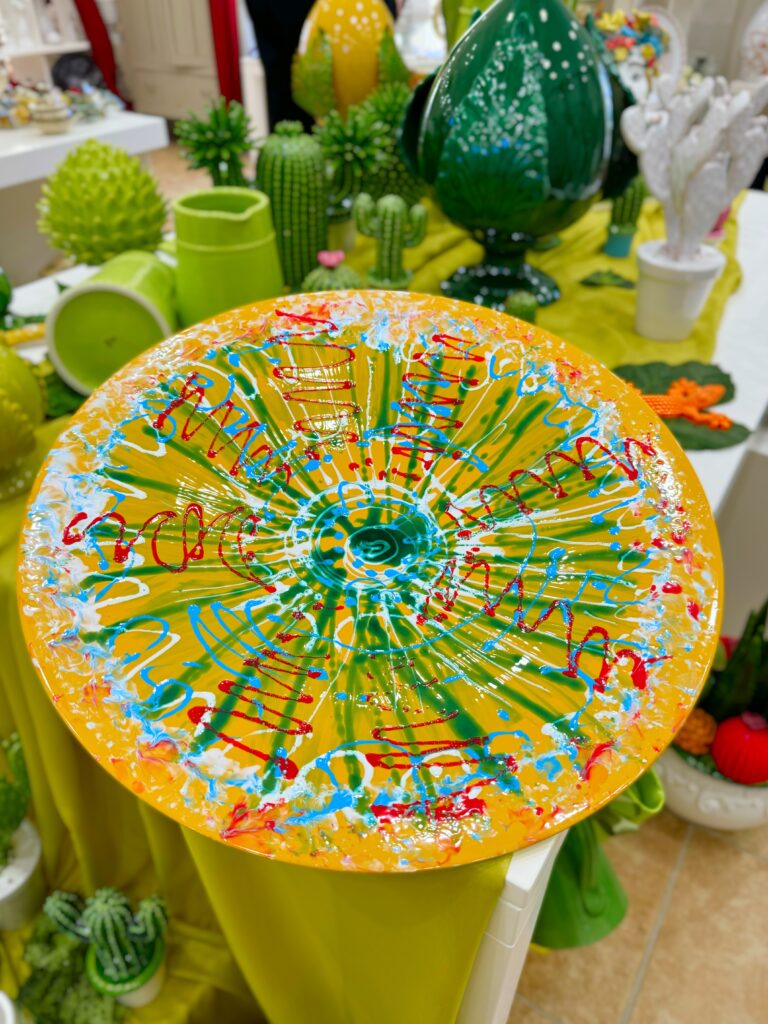
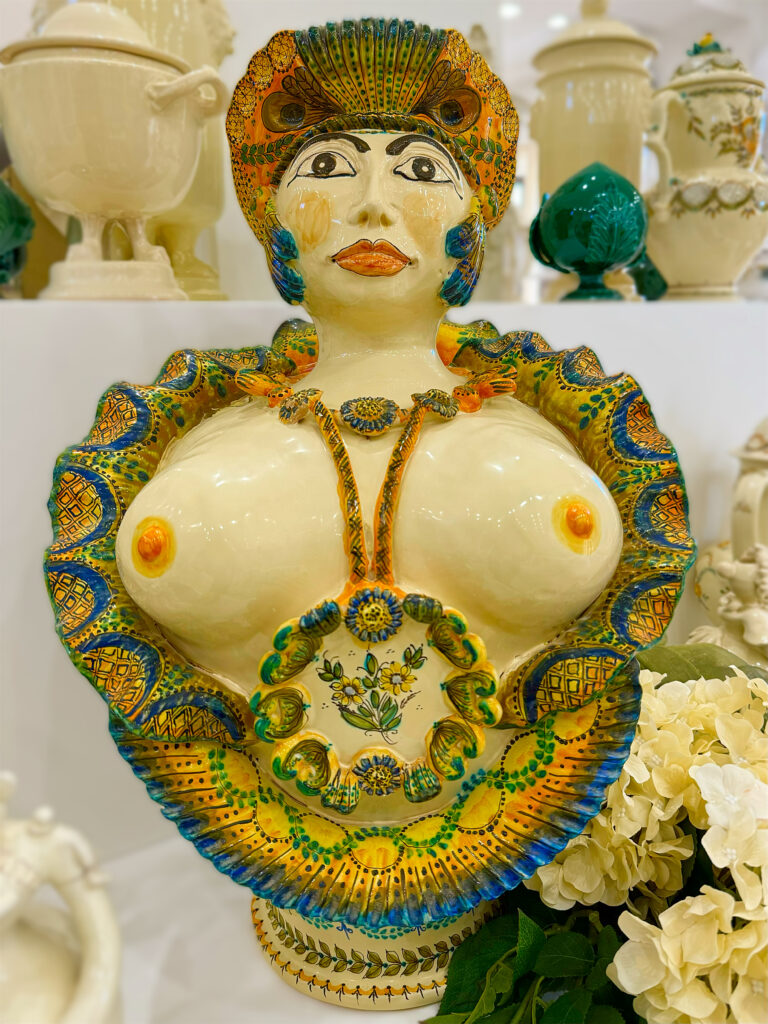
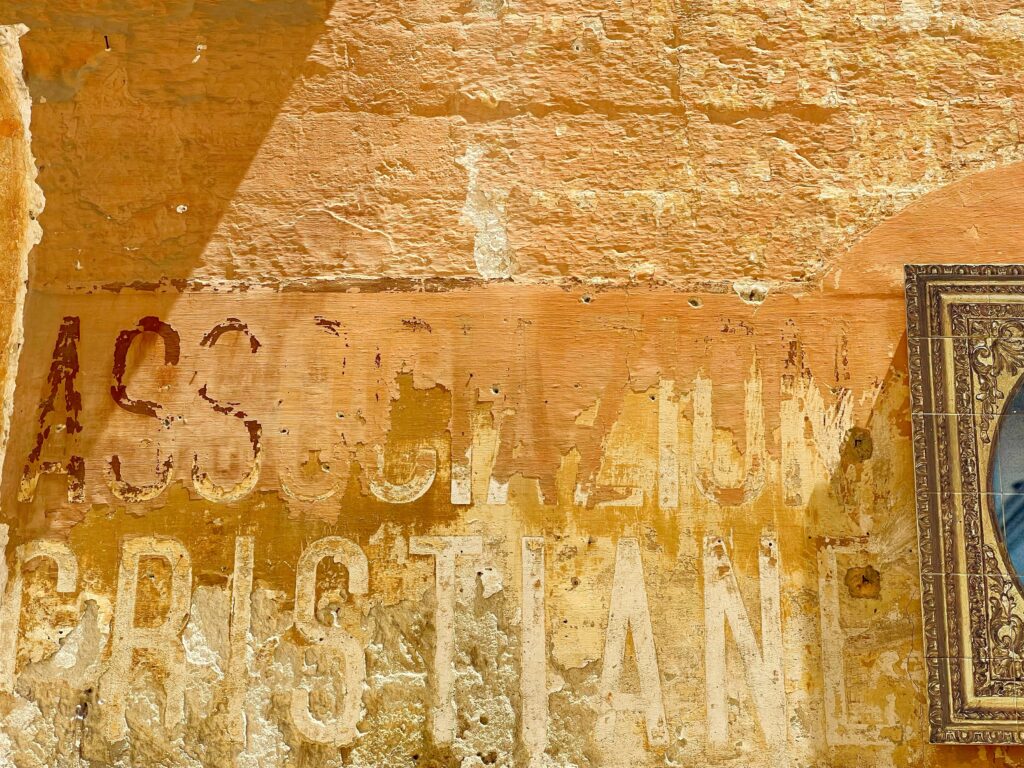
For coffee, we recommend ‘Bar delle ceramiche’, they usually make their own pasticciotti with excellent filling.
Walk around Grottaglie’s old town. Much of it has been renovated, but it still has deeply loved older buildings with history to tell. Thanks to the local art school, it also has very interesting street art.
Stay for lunch. Two excellent restaurants we usually eat at are:
Macchiaviva Bistrot | This has become our default Grottaglie restaurant. A lovely space matched by excellent food. Serving up traditional cuisine, using ingredients sourced locally from artisan producers. Run by sisters Anna (front of house) and Loredana in the kitchen, cooking with her mama Carmela, they are knowledgable about ingredients and wine. Amazing dessert contributions inspired and made by their mama | Via Cavour 13, 74023 Grottaglie | +39 099 450 4695
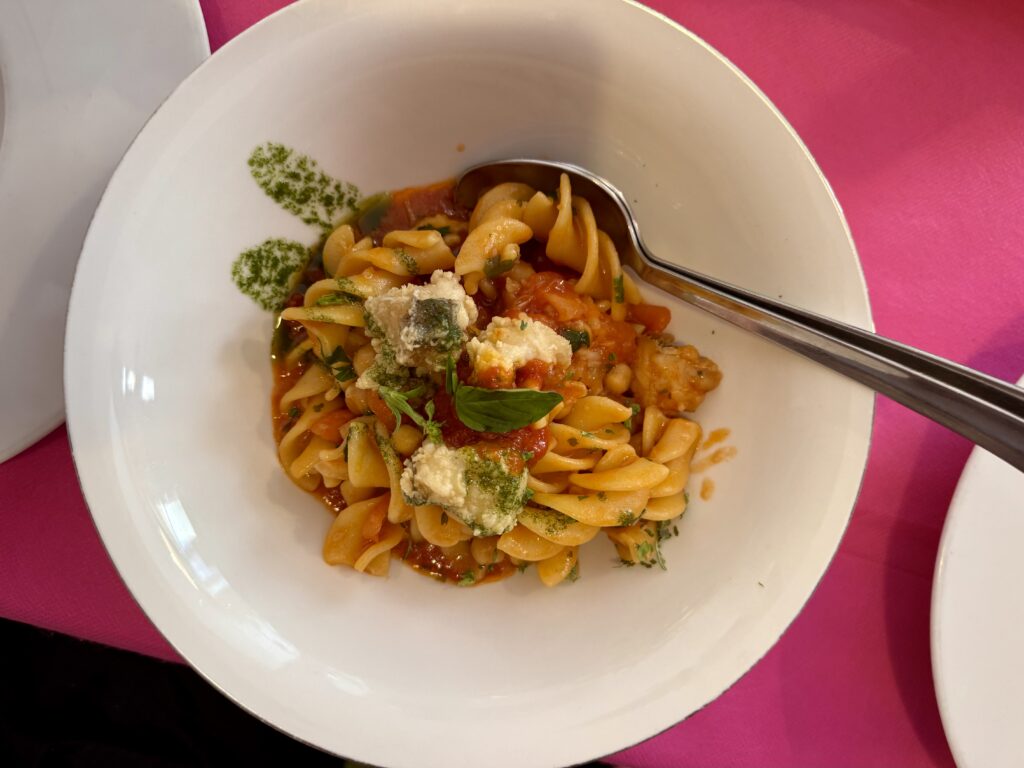
Trattoria la Luna nel Pozzo | Delicious, traditional dishes in the slow food tradition, run by husband and wife team | Via L. da Vinci, 4, 74023 Grottaglie TA | +39 373 784 2289
OR, alternatively head to Taranto’s borgo antico for lunch.
Taranto
A half day to explore Taranto’s borgo antico, including lunch (or dinner).
Wander around the streets of the old town, visit the stunning marble decorated 3rd apse of the duomo and eat cozze tarantine at exceptional seafood restaurants.
Famous for their farmed mussels. Eaten raw or steamed in a simple broth, they have become a taste obsession.
Then there’s the old town itself. Much of it dilapidated. A maze of small shops and restaurants, where whole houses can be bought for 1€. Raw and gritty, yet breathtakingly authentic. Scattered on its edges, a few fine restaurants with exceptional seafood and fish. Fresh and local. So local, you can probably follow the trail of water drips to the boardwalks along the quayside where it was bought from the fishermen who landed it.
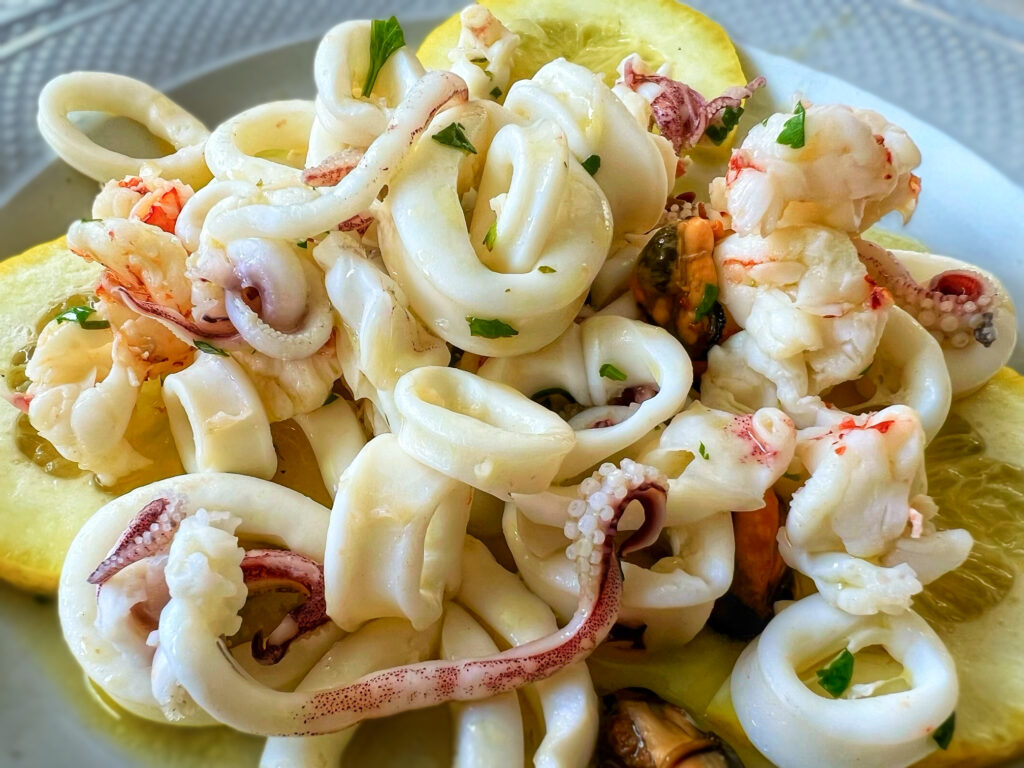
For our restaurant recommendations and what to see, see our Taranto city guide: troubled Taranto and the beauty underneath.
Gallipoli
Good for a full day trip and spectacular sunsets.
Take in the old town, enjoy a lazy lunch (and dinner if you have time) followed by a long afternoon on the beach, under the Salento sun. Gallipoli offers breathtaking sunsets. Savour this daily spectacle with a glass of local wine and olives from a rooftop terrace or on a nearby beach.
Take your time to meander through its winding streets, alleys, and hidden corners. Here you can discover the longtime residents going about their daily business, the fishermen mending their nets or weaving lobster pots and fishing baskets.
Spiaggia della Purità – the city beach, half-way around the old town perimeter, is the perfect place to soak up the sun and sea breeze, and to watch the sun set of an evening.
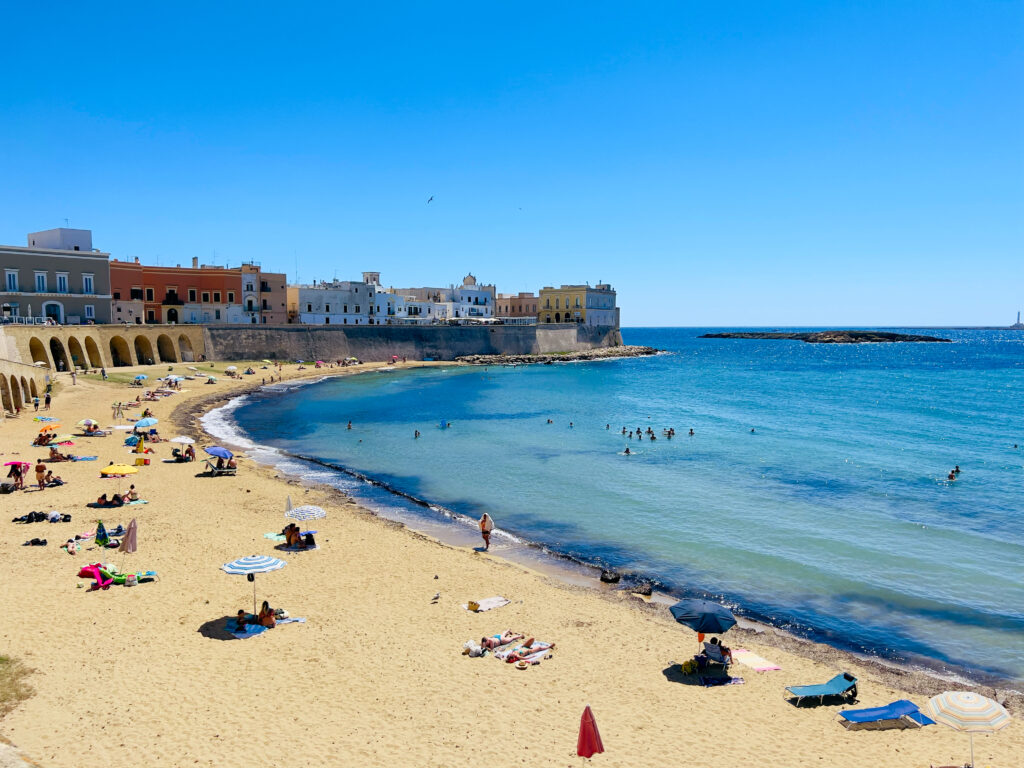
For lunch or dinner, head to La Puritate, a rustic trattoria known for fresh, top quality seafood dishes, all while enjoying the serene views of the sea. The restaurant is next to the Chiesa della Purità, sitting above spiaggia della Purità. Popular with locals, we suggest linguettine alla Puritate as primo (small linguine with small prawns, thin strips of courgette and cherry tomatoes) followed by the theatrical gamberoni al sale. | Via Sant’Elia, 18 | trattorialapuritate.it
Ristorante Il Bastione is a family run restaurant. It’s terrace offers beautiful panoramic views over the sea, and a perfect sunset | Riviera Nazario Sauro, 28 | ilbastionegallipoli.it
Otranto
Spend half the day on one of the city beaches, enjoy a lazy lunch, and the rest of the day sightseeing.
For coffee, gelato and a morning pastry: Martinucci Laboratorio.
City beaches and swimming: all around the port. Just head to the old town. There are beaches outside the centre but we focus on city beaches here.
Sightseeing: stroll around the old town streets, visit Cattedrale di Santa Maria Annunziata (with its historic tree of life mosaic floor, and the gruesome skulls of the beheaded martyrs of Otranto), the Aragonese Castle (the inspiration for the first ever Gothic novel) and, out of town, the Bauxite Cave (a disused quarry).
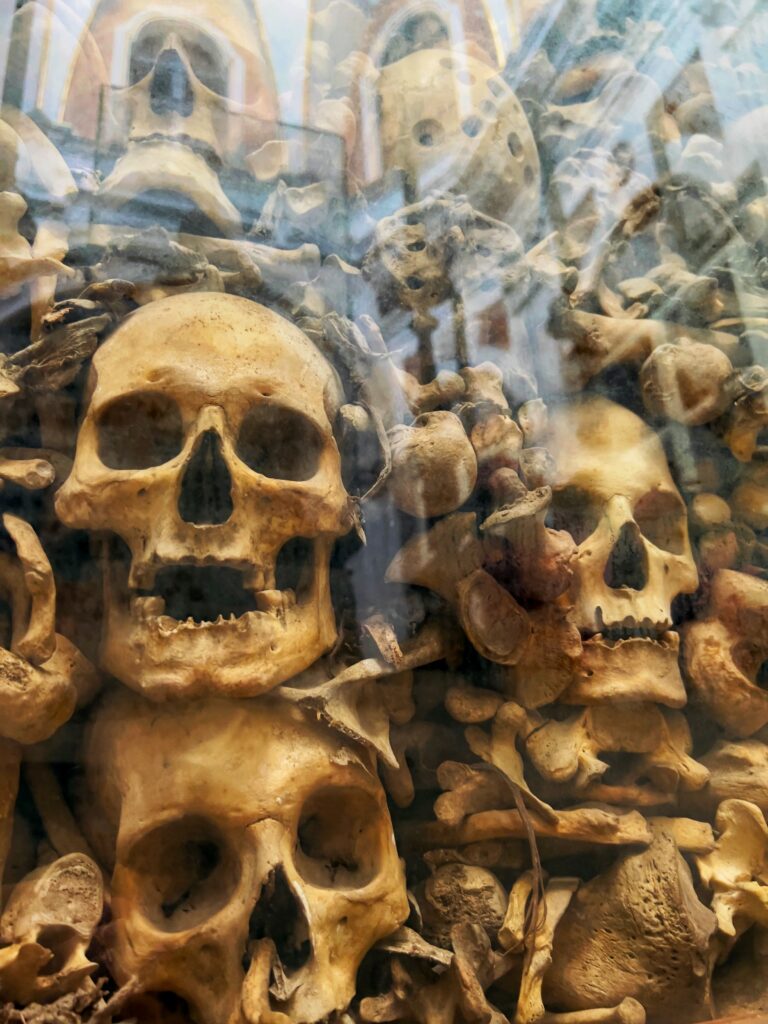
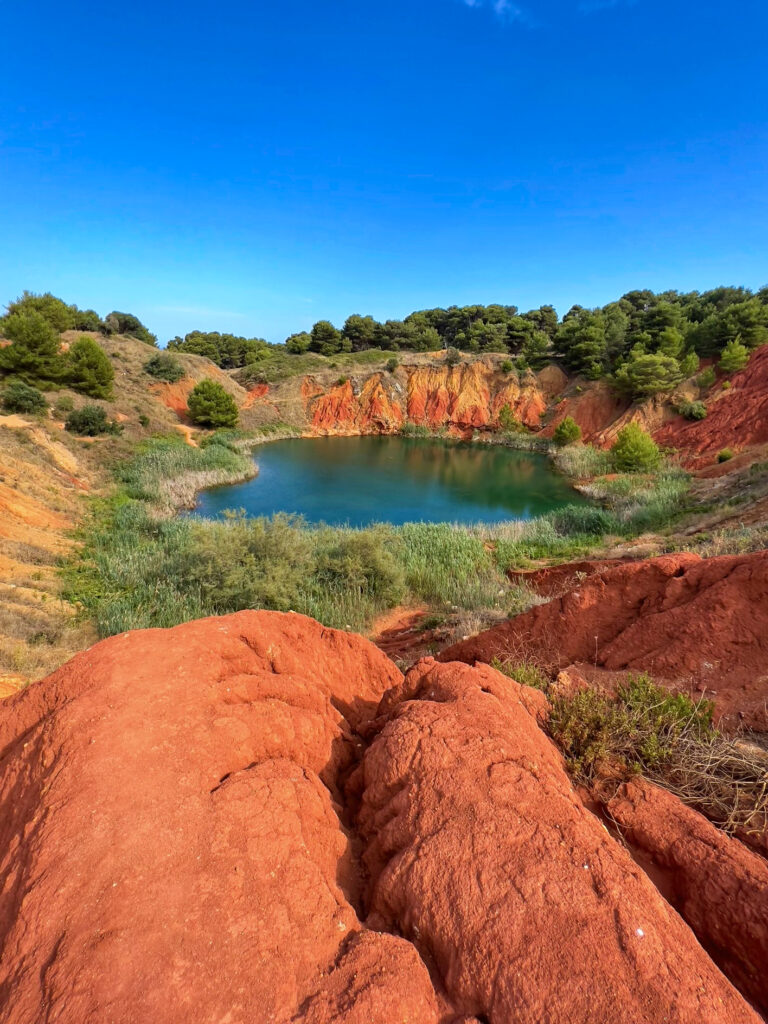
Eat: we usually choose LaltroBaffo Ristorante, a fish restaurant tending more towards fine dining.
Plan the perfect Puglia itinerary | Puglia Road Trips
Puglia itinerary #1 | Otranto to Santa Maria di Leuca
This is our favourite road trip and we would urge you to include it in your Puglia itinerary. An absolute highlight of a trip to our region, and one we make at least 3 or 4 times each summer.
The route along the coast is one of the most dramatic in Puglia, sandwiched between prickly pear lined cliffs and shimmering sea. This is not the Amalfi. The drive is leisurely, the pace easy.
Time saving tip | If we have been staying in Lecce we head to Otranto, BUT when we come from Ostuni – probably the furthest away we recommend doing this journey as a day trip – we bypass Otranto and head directly to Santa Cesarea Terme to start the drive along the coastal route from there. To save more time, head directly to Castro and start there.
Otranto | Santa Cesarea Terme
Distance | 18 km
Head south via the bauxite cave (la cava di bauxite), less than a 10 minute drive from the centre of Otranto.
A disused quarry and man made lake (bauxite is the main source of aluminium) returned to nature, creating a vividly coloured landscape of emerald green lake and ferrous red soil, framed by the glorious green trees and Puglia’s endless blue sky.
Park in the nearby car park (3€ fee) it is a short walk of a few minutes along a defined path to the bauxite quarry. The morning and late afternoon sun best compliments the colours.
Look out for the nearby Torre del Serpente, the symbol of Otranto. If the weather conditions are clear you can see Albania on the other side of the Adriatic.
On the road again, further along the coast is the Faro di Punta Palascìa lighthouse, a remote 19th-century lighthouse that marks Italy’s most easternmost point.
7.5km north of Santa Cesarea Terme is Porto Badisco.
Santa Cesarea Terme | Santa Maria di Leuca
Distance | 35 km
Choosing your own pace, decide where you might want to stop off, for sightseeing, for coffee, or for a swim.
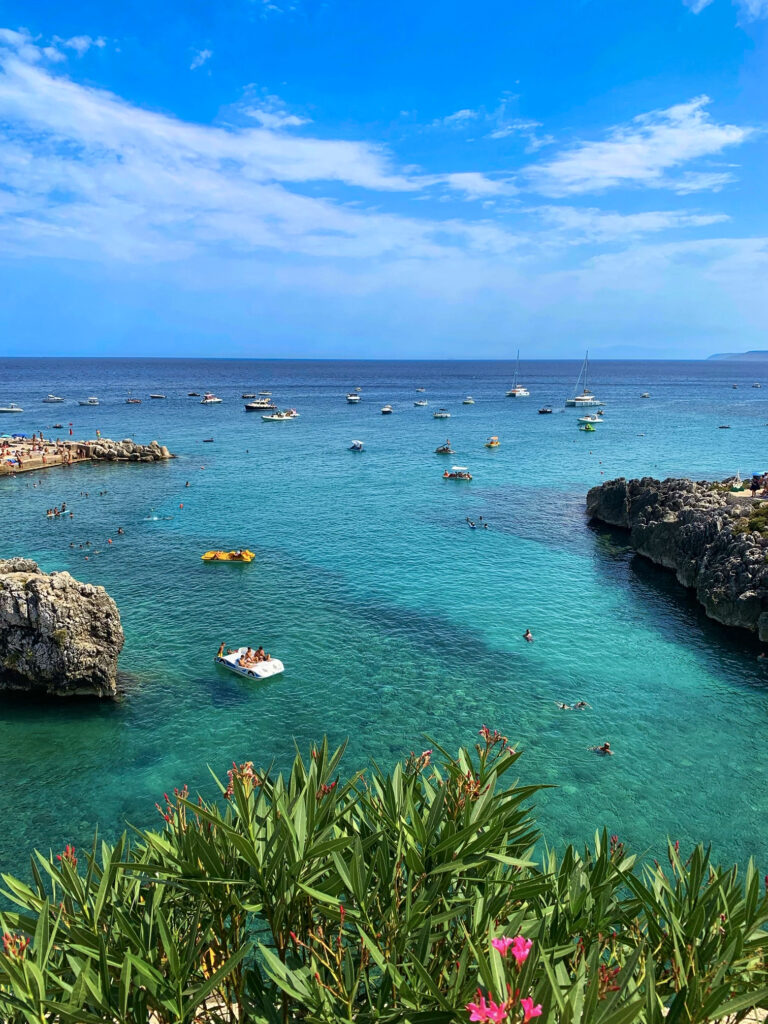
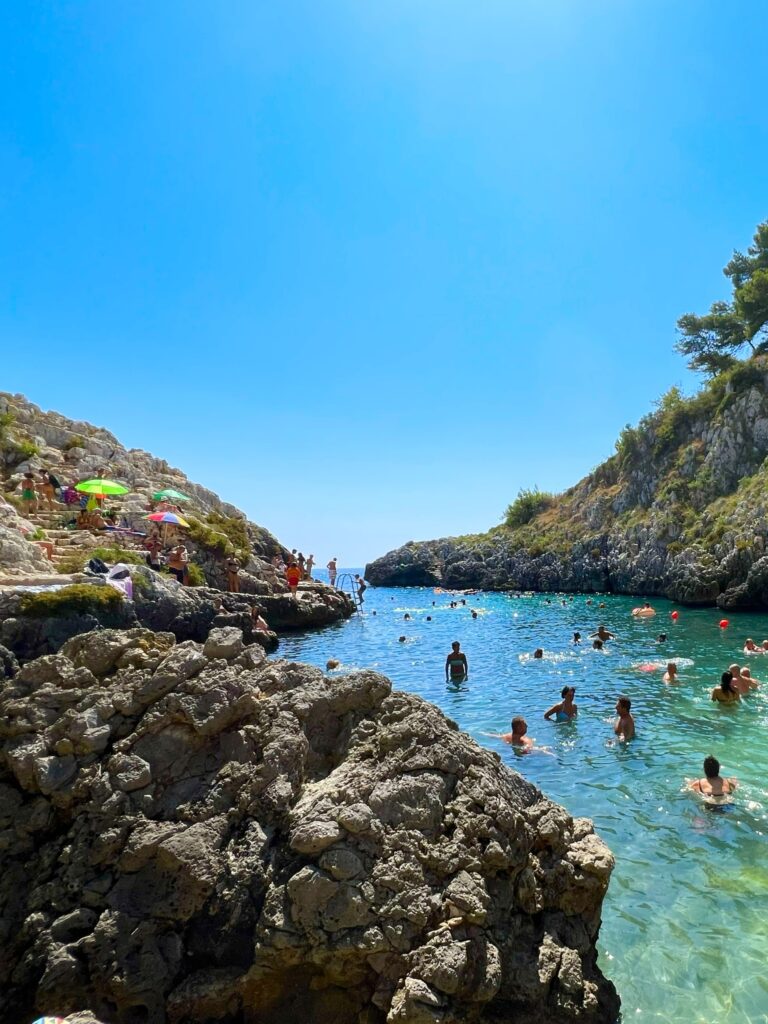
Hugging the SP358 through Castro (during the summer peak traffic is diverted south of Castro to Marittima and back out at Cala dell’Acquaviva), Porto Tricase (where another one way system will divert you away from the coast towards Tricase ; just follow it – you will return) and by Marina Serra and il Ciolo until the lighthouse at Leuca announces your arrival. Continue to the lungomare. The old port and the art nouveau villas that line the seafront open up along the way.
Lidos sit on wooden platforms along Leuca’s lungomare. Be sure to take some ciabatte – rubber soled shoes – for swimming. These are a necessity for taking to the crystal clear waters lapping over jagged rocks peppered with sea urchins, whose spines present another hazard to the bare footed.
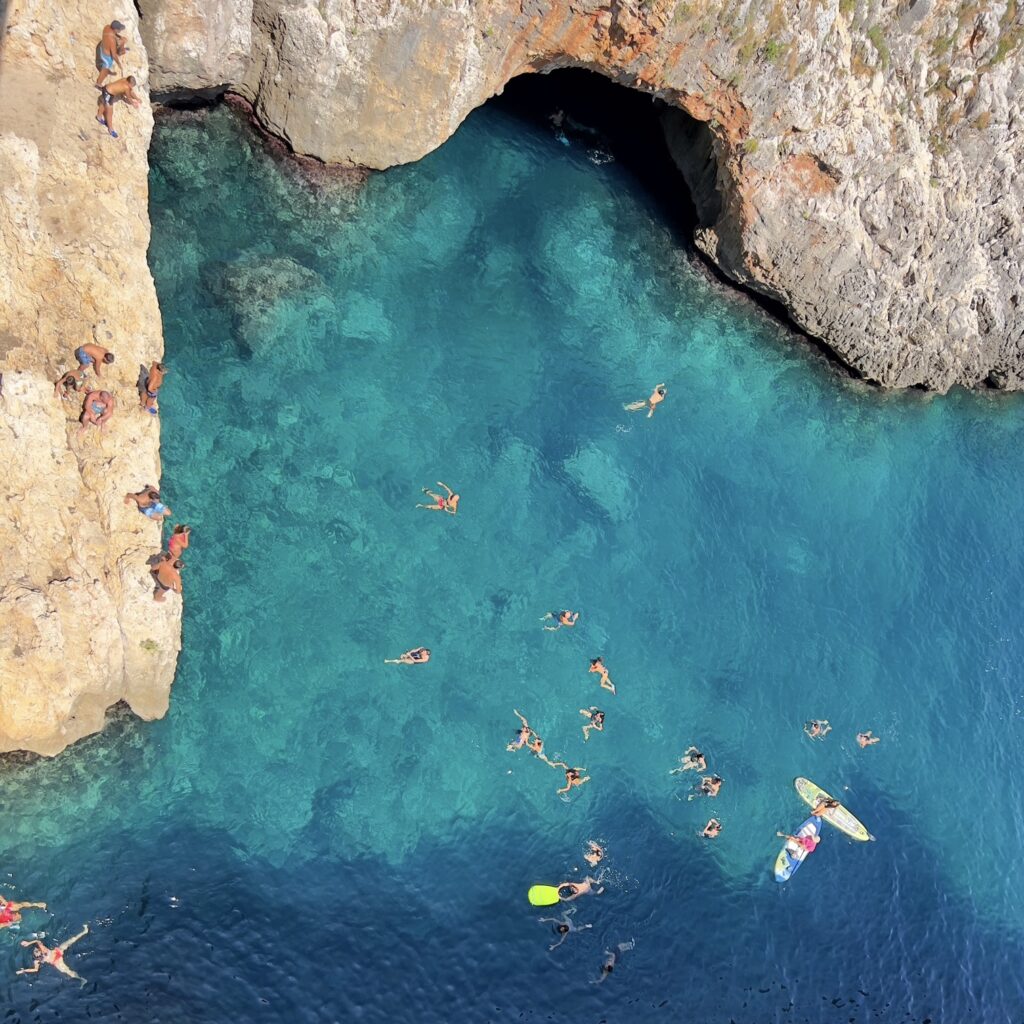
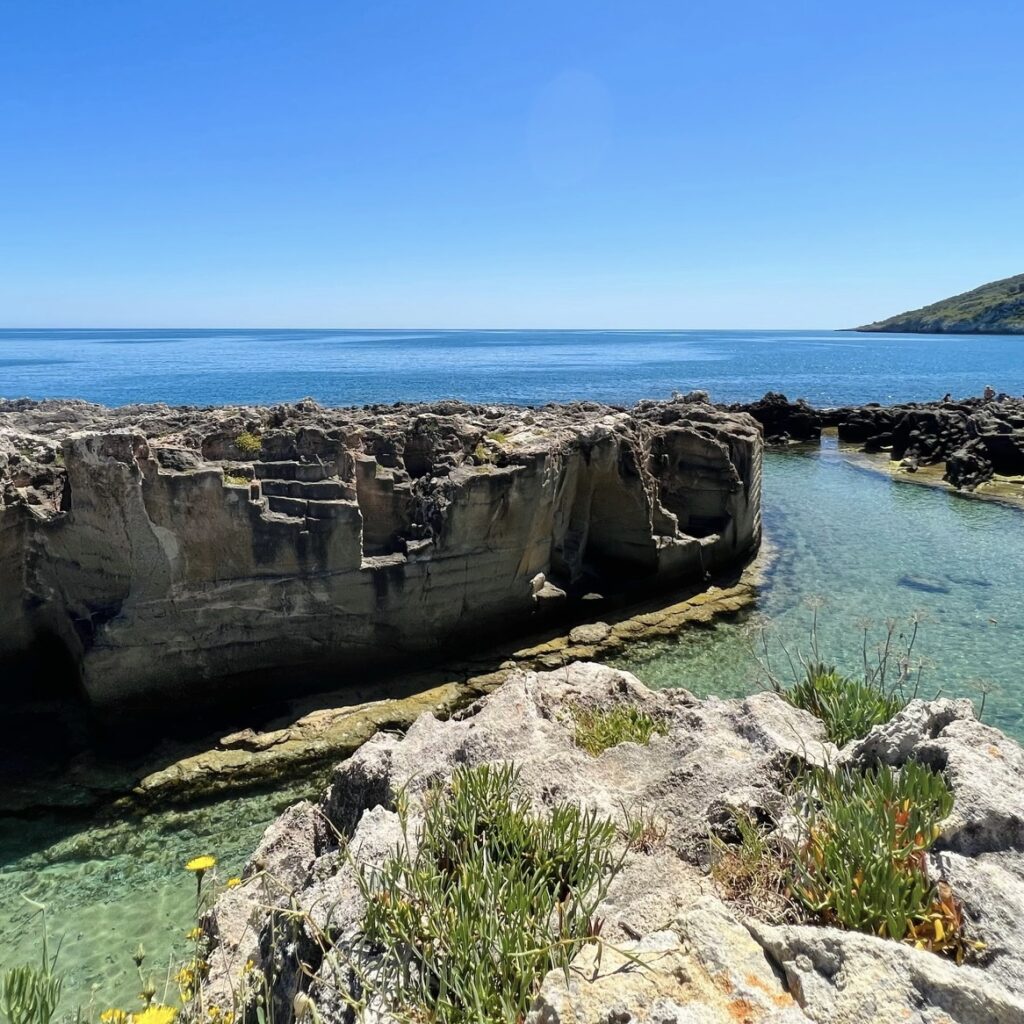
Grab some frittura at Lido AlbaChiara. There you can enjoy the view over the azure waters while watching local teenagers snorkelling for urchin and polpo to be served at the next meal.
That’s the thing about Santa Maria di Leuca. It all comes back to the sea.
Getting to Santa Cesarea Terme from | Otranto 18 km | Lecce 50 km | Gallipoli 50 km | Ostuni 130 km.
With extra toppings
The drive itself is only 50 minutes, but we prefer to amble and explore along the way.
Sitting on a plateau that plunges into the sea Santa Cesarea Terme will remind you of Polignano a Mare. Bathe in the thermal waters, or enjoy the north African ambiance of the Palazzo Sticchi.
Buy the freshest street food in Castro. Locally caught fried fish from the friggitorie, served up in cartoccio accompanied by a small bottle of chilled white or rosé wine. Perched on cliffs 100m above the sea Castro is Puglia’s balcony over the Adriatic.
At peak summer traffic is diverted south of Castro to Marittima, brining you back out at Cala dell’Acquaviva, a picturesque secret bathing spot.
Stop off for a coffee at Porto Tricase. Watch the bathers taking a cooling dip in the green waters of the small beach at the little harbour, home to the town’s fishing boats.
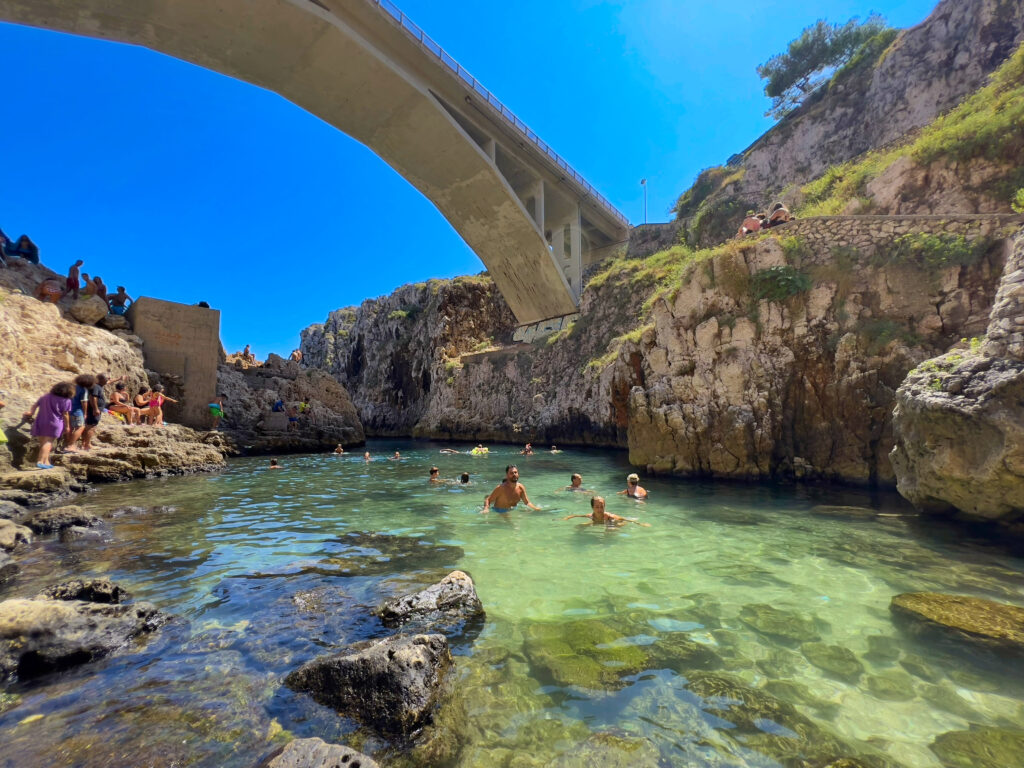
Caletta del Ciolo some 8km before Leuca is a coastal ravine for hiking, cliff-diving and swimming with scenic views from the bridge over the canyon. Parking can be challenging, and the bathing space is limited, but the views are stunning. Another of Salento’s secret swimming places.
Supersize me
Instead of a day trip, spread this over two days.
Stay the night in Marina Serra. This allows an evening detour to nearby Tricase for a pre-dinner aperitivo at Farmacia Balboa. The old town pharmacy sits on a small piazza and has been sympathetically transformed into a cool cocktail bar retaining many original features. Its co-owner Dame Helen Mirren has a summer house in the neighbouring town of Tiggiano.
A couple of doors down is the Castel di Salve wine shop (their winery/cantina is in the wonderfully named neighbouring town on the other side – Depressa; though we are sure it’s not at all). They have great locally produced wines that taste of the Salento sun. Nothing brings a smile to our face like buying a 15 litre box of their Santi Medici Rosso negroamaro to take home.
For dinner Locanda Del Levante around the corner is our choice.
Be sure to get up in time to watch the sun rise over the rocky shelves that surround Marina Serra’s swimming basin along with the locals taking their daily early morning constitutional.
Puglia itinerary #2 | Valle d’Itria
Many visitors plan their Puglia itinerary around the Valle d’Itria. The drive through the Valle d’Itria is quite beautiful. Rolling olive groves, the white cities. There is no specific route required, it is an incidental bonus when driving between Ostuni to Cisternino and Locorotondo, then onward Francavilla Fontana and Alberobello. From Alberobello it is worth driving over to Monopoli for the views coming downhill.
To help plan a Puglia itinerary focussed around the Valle d’Itria Keep in mind a couple of things.
Distances | exploring with ease
If you have a car most of Puglia’s best known destinations can be covered by day trips from a central base, without changing accommodation every day or two. Many of Puglia’s towns, especially around the Valle d’Itria, are close together. For example, Ostuni, Cisternino, Locorotondo, and Martina Franca/Alberobello are each about 20 minutes apart by car. The same goes for Ostuni to Ceglie Messapica.
Driving from Ostuni to Monopoli takes just 30 minutes, and Monopoli is only 10 minutes from Polignano a Mare. We often enjoy a full day visiting Alberobello in the morning, Monopoli for lunch and stroll around the old town, and then Polignano for an afternoon gelato and beach visit followed by an aperitivo in the old town, all without feeling rushed. The short distances make it easy to explore multiple towns in a single day.
While some travellers opt to move between towns, staying a night in each, it can become a hassle packing up and checking in repeatedly. A smart alternative is to use a central base like Ostuni for 3-4 nights and explore the surrounding towns at a more relaxed pace – just as Puglia is meant to be enjoyed.
Insider tip | Longer stays can save on accommodation costs. Some accommodation like Ostuni’s popular Apartment Q40 offer up to 10% discount on stays of 7 nights or more.
Take a look at our Essential Puglia, Day Trip Planning and Puglia’s Best Road Trips companion guide to make the most economical use of time and distance.
Puglia’s white walled cities | ✔️✔️and ✔️
When planning, remember that towns like Locorotondo, Cisternino, and Martina Franca offer similar experiences in terms of setting, atmosphere and eating. You might not need to visit each one, especially if your time is limited.
Puglia itinerary #3 | Bari to Vieste
Distance | 175 km | via SS16
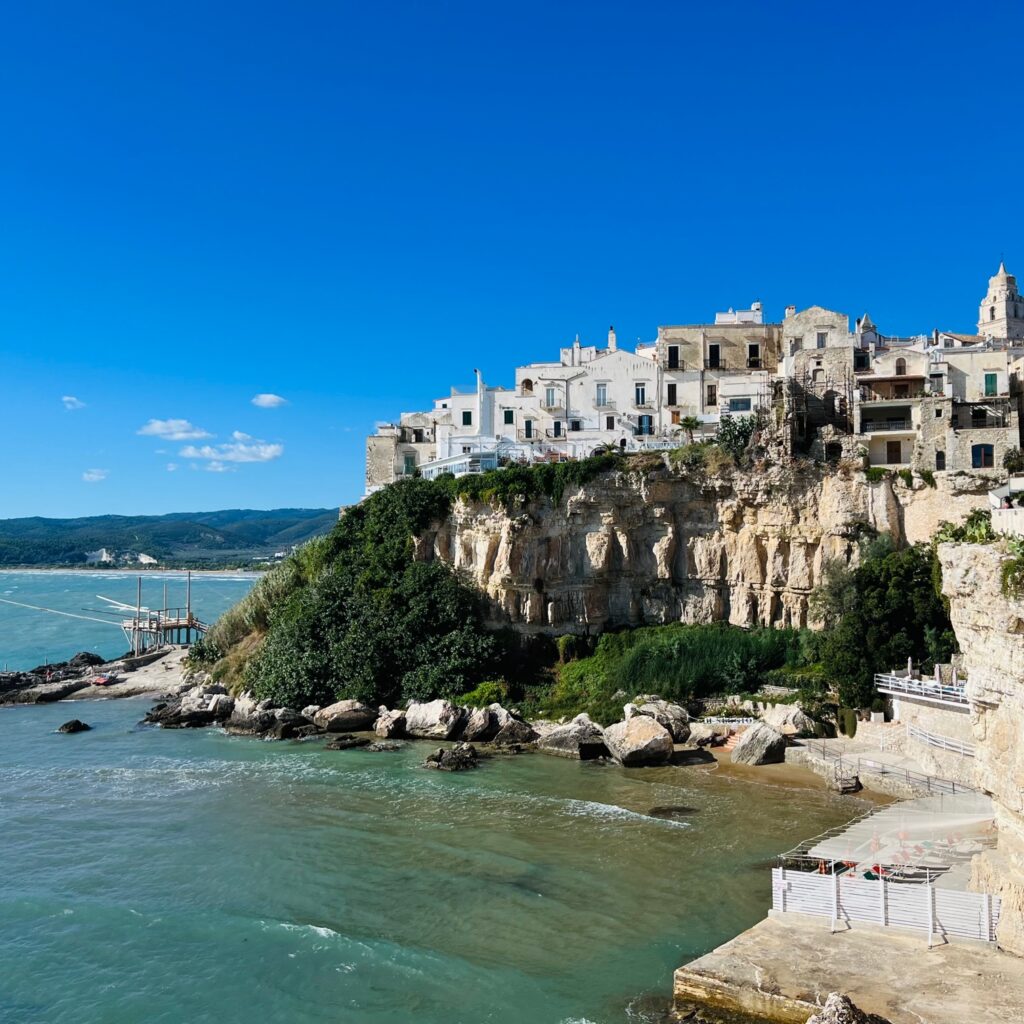
We head north to the Gargano. Situated within the spur of Italy’s boot, it’s a huge forest, with a stunning coast, amazing beaches and the trabucchi. Fishing structures resembling steam punk North Sea oil rigs.
If the Valle d’Itria is the most visited part of our region then the Gargano is the most overlooked. Rising up in the distance as you pass along the salt flats of Margherita di Savoia it feels very different to the rest of Puglia – albeit with similar accents of olive groves and azure waters.
The drive through the ancient oak and beech forest will offer glimpses of a dramatic coastline of coves and caves cut into the white limestone cliffs and long sandy beaches.
Route
As this is a two and a half hour drive, we recommend making the most of this by staying the night in Vieste and returning to Bari after a late lunch in Peschici.
Take the SS16 | 2h29m route shown rather than the default A14 – Autostrada Adriatica (E55) route. This avoids the €6,80 toll and is a more interesting drive through Margherita di Savoia and along the coast.
Route | SS16 | take exit Barletta Nord | merge onto via Foggia and onto SP141 for Margherita di Savoia | when approaching Manfredonia follow the signs to Mattinata/Vieste and merge onto the Strada Statale 89 Garganica/SS89 | stay on Strada Statale 89 Garganica/SS89 to Vieste.
With extra toppings
Stop off in Trani (50 minutes from the centre of Bari) for a coffee and pastry. Head to the Porto di Trani (the Trani Sant’Angelo exit) for coffee and a pastry and a walk around the old port with its picturesque cathedral. Or you can lunch at the Michelin starred Quintessenza Ristorante. Attentive service, without being overly fussy. Food excellence is reflected by price, though not prohibitive | Via Lionelli 62, 76125 Trani BT | +39 0883 880948
Continue the drive through the salt flats of Margherita di Savoia, pull into the side to see the flamingos.
Eat Vieste: try the pepata di cozze (peppered mussels). Served in the shell and a delicious broth it may look similar to moules mariniere, albeit without cream. Unlike moules mariniere the wine and garlic do not overpower the broth, enriched by the olive oil and beautifully fragranced by the black pepper.
Alternatively choose a paposcia from the range of paposce on the menu. Similar to a panini but with a crispy wood oven baked focaccia, made exclusively from olive oil from the ancient olive oil trees of the Vico del Gargano. Named after the slipper shaped focaccia this speciality of the Gargano region going back to the 16th century.
Beach
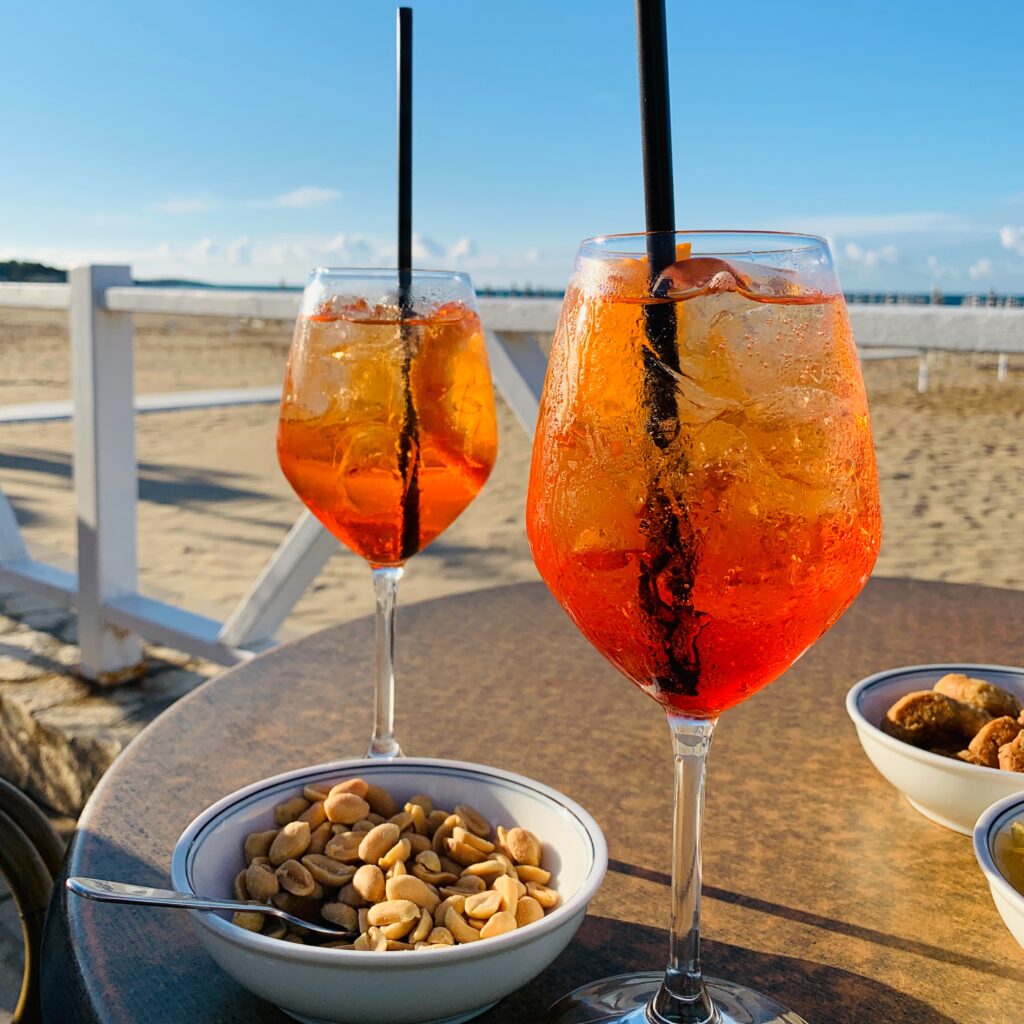
Spend the afternoon on the beach. Vieste has two long stretches of sandy beach, either side. Both have a selection of private lido clubs and public beach.
The longer stretch is of beach is on the southeast side of the town, where Pizzomunno stands watch. You can park along the lungomare (approximately 1€ /hour). On the northwest side is a shorter but deeper beachfront, again filled with lido clubs. A huge car park sits between the beachfront and the hotels (approximately 1€ /hour).
Peschici
A 30-minute drive along the coast, north of Vieste.
Along the coast of rocky beaches and translucent turquoise waters, between Peschici and Vieste, are the trabucchi.
These … “strange fishing machines, all composed of planks and beams similar to giant spiders” stand like a cross between steampunk North sea oil rigs and sail-less ships. Some double as restaurants where fresh fish and seafood are served up with cold beer, bread and slices of lemon.
Spend the morning on one of the beautiful beaches either side of Peschici before heading to Trabucco da Mimì, a must for lunch (booking essential); the food, the location – one of Puglia’s best dining experiences. We suggest booking a terrace table for 1.30pm. Don’t think about finishing until after 3pm.
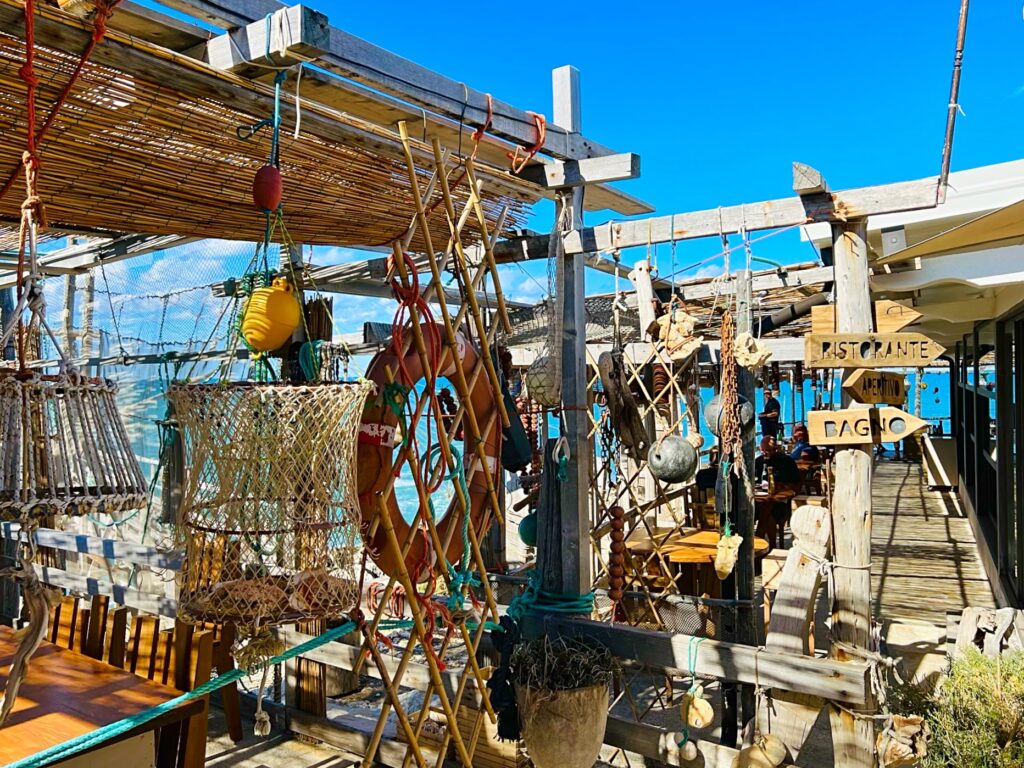
Alternatively you can eat at their bar area, though this is a wonderful spot to watch the sunset. Al Trabucco also has amazing accommodation. Serviced cabins. We stayed there on one of our visits. The location is exceptional.
After lunch be sure on the way back to Bari be sure to stop off at Azienda Agricola da Rocco.
It’s a stall on the side of the road just 5 or so minutes from the trabucco, en route towards Vieste.
Rocco has amazing cheese, garlic and chilli peppers. Not to say jams, preserves, delicious stuffed chillis and amazing chilli paste. We filled up, and also sampled his caciocavallo, wine, olives…
Tell him we sent you.
More | our visit to Trabucco da Mimì
Plan the perfect Puglia itinerary | Boat trips
We often hire a boat either at Castro Marina or from Santa Maria di Leuca. These allow you to coast along the coast, for a view and scenery we don’t see from the road.
We use Nautica Red Coral at Castro and Piccola Nautica in Leuca.
We enjoy the Leuca hire more because it let us explore the Adriatic, some of the caves before we head up the Ionian and a stop at Torre Vado. We had more variety and diversity of coast to see when we took the boat from Leuca.
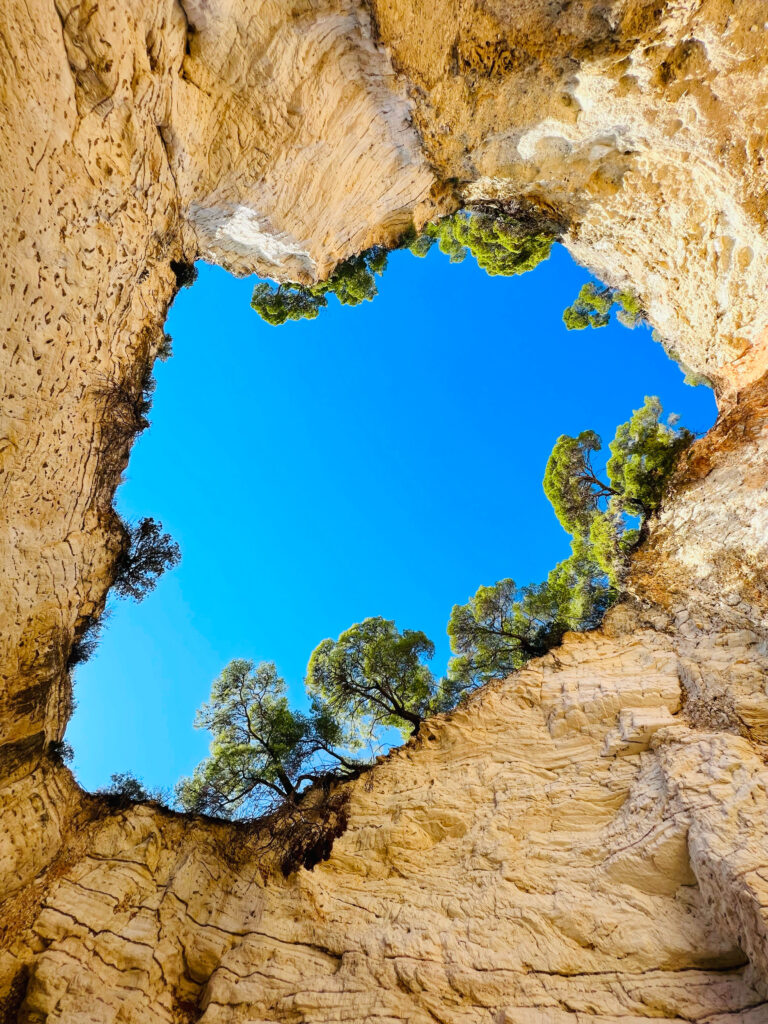
As well as boat rentals they both do boat tours, if you are not confident about being your own captain. One place we definitely do a boat tour is when we visit Vieste. We did the Desirèe imbarco Tour Grotte Marine which took us just beyond the spectacular Faraglioni di Baia delle Zagare. Depending on the sea conditions, the boat navigates some tight spots to get into caves and stops off (usually at Spiaggia di Vignanotica) for swimming.
Plan the perfect Puglia itinerary | Walking trips
Porto Selvaggio
A little less than 20km north of Gallipoli, Porto Selvaggio is one of Puglia’s most beautiful nature reserves. Covering 1100 hectares it is thick with pine forest.
Our tour took a little under 4 hours, from Masseria Torre Nova down to the main bay at Spiaggia di Porto Selvaggio (a busy and popular beach, despite being all rock and pebble) following the coast up to Torre Uluzzo. The terrain becomes a little more challenging around Grotta del Cavallo and up to Torre Uluzzo with a steep ascent, climbing around some rocks.
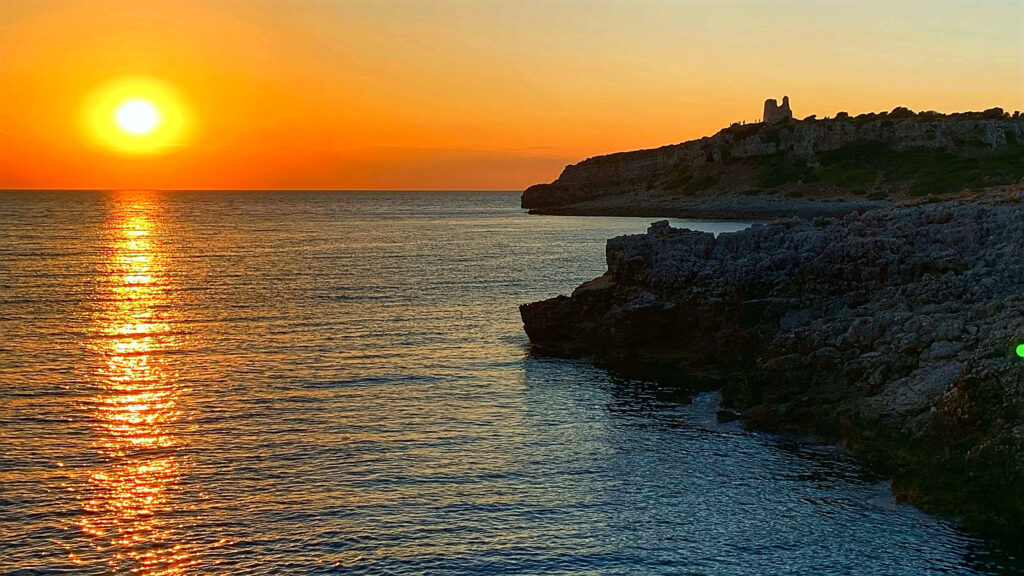
Sensible shoes (trainers) and long trousers to protect legs against the scrub and thorns you will trek through are recommended.
More information on tours with Giacomo De Mitri can be found on his facebook page. Tours are in Italian.

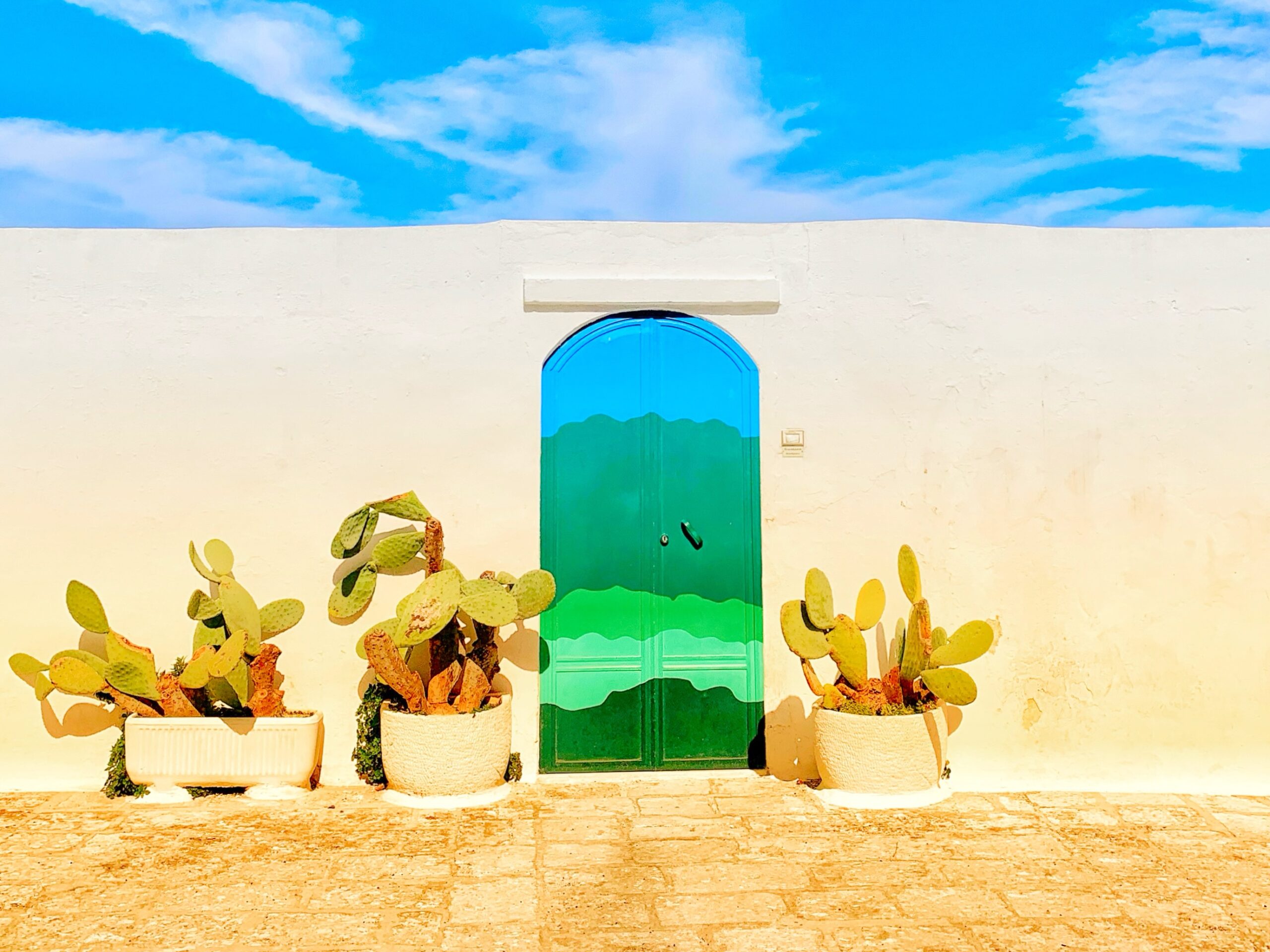
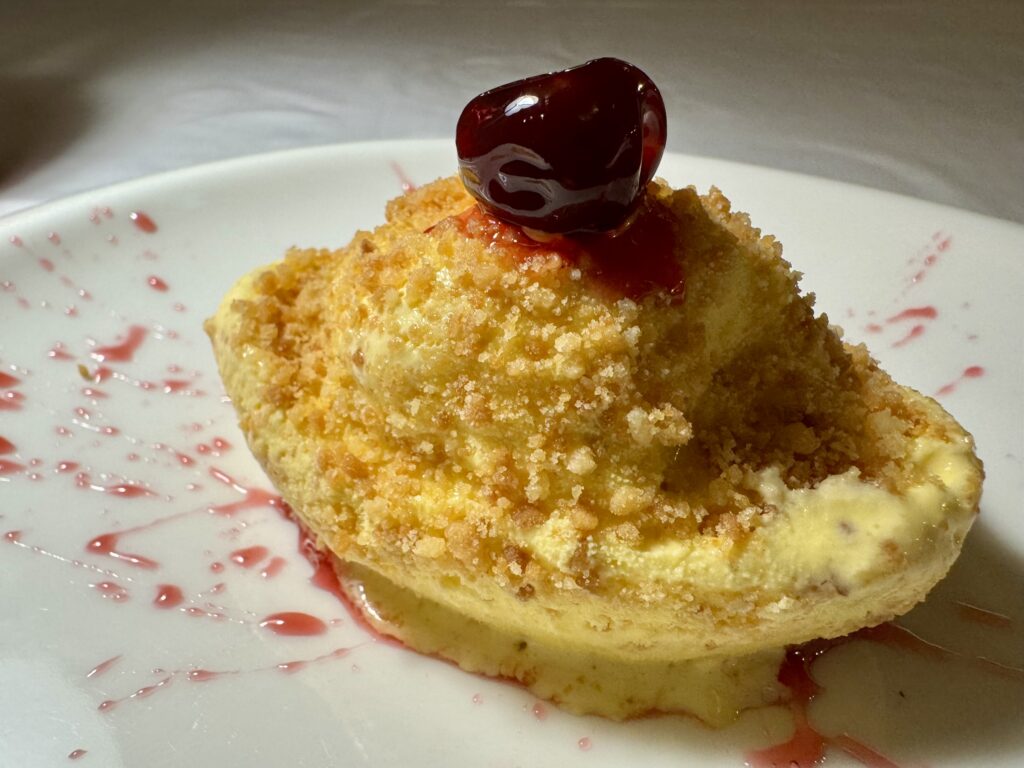
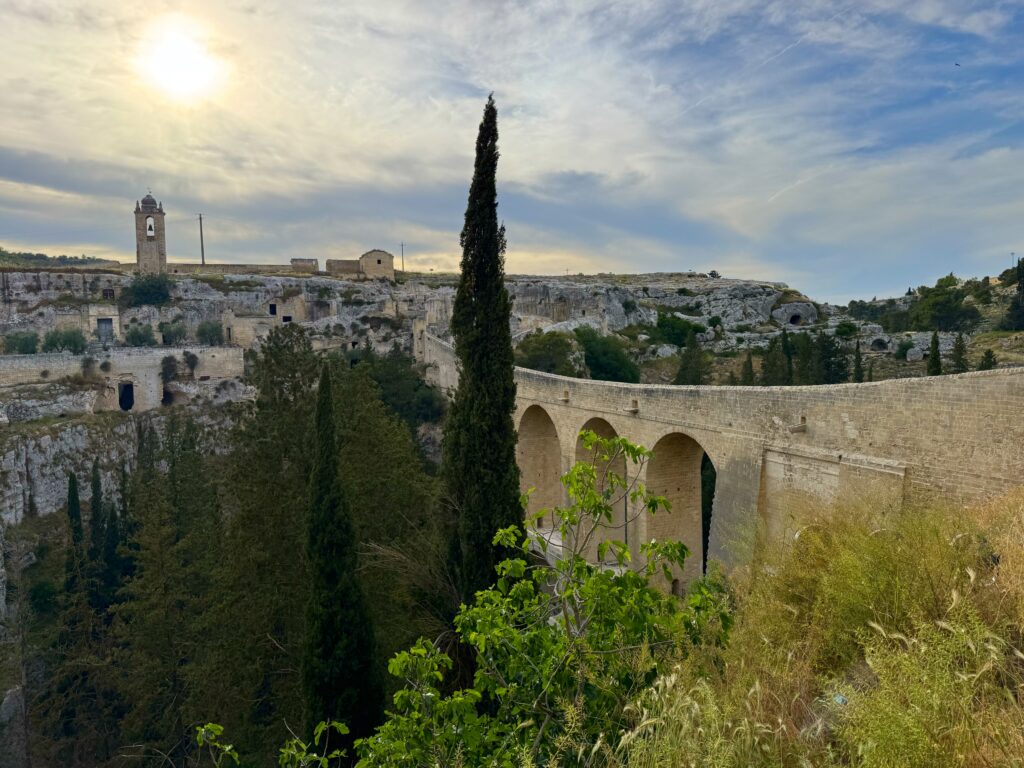
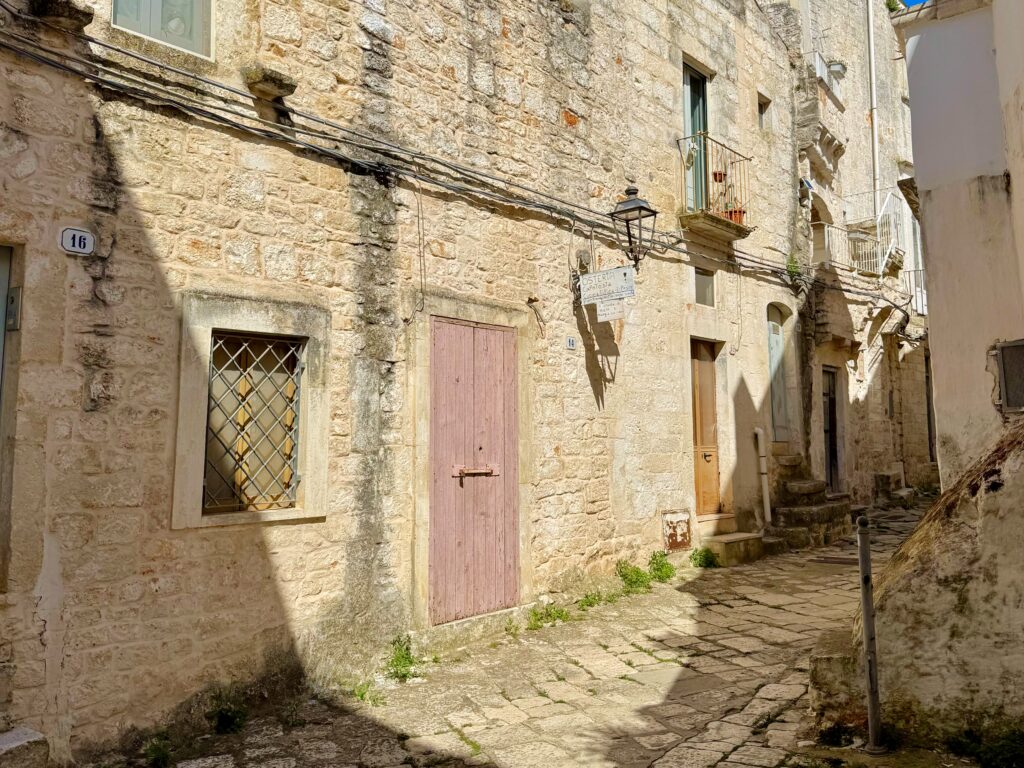
Hi guys! My husband and I will be going to Puglia in early October. We’re struggling to figure out a good 5 day itinerary. We will have a car. We know we definitely want to visit Lecce and Matera. But we’re not sure what the best beaches and smaller towns to hit. We’d also like to stay at an authentic masseria. Any recommendations would be appreciated!
Ciao
We don’t know whether your preference is long stretches of golden sand, or rocky shelves to bake on. But to help up you choose, our Puglia beach guide has a very wide selection of beaches all around the coast, with a description (sandy vs rocky, for example).
Five days is a short time and Matera, in the neighbouring region of Basilicata, and Lecce have so very many small towns in between. In fact some of our favourite small towns are even further south in Salento. Our travel style is to relax, chill and not have a frequent change of accommodation. But we all have different travel styles so our itinerary guides will certainly help you plan a stay that suits your itinerary.
As for a masseria, have you checked out our Puglia Guys masseria guide? That has all the information we have to offer for the moment.
Buone vacanze
LuigiM.
Ciao, we will be travelling in the region from Sept 6 to 20 coming into Rome or Naples. My plan is to rent a car for the duration. There will be 4 of us for 7 days and then 3 for the balance of the trip. I was thinking of the following locations with the days in brackets: Bari (2), Monopoli (2), Alberbello (1), Ostuni (2), Lecce (2), Matera (2) and Sorrento (2), with day trips from each location. Do you recommend choosing 2 or 3 bases rather than the 6 (excluding Sorrento). Thank you for the fantastic site and taking the time to read/respond to my post. Grazie.
Ciao from Puglia. We cover this in our Slow Travel Guide to Puglia. Limit Accommodation Changes: A central base allows for smart itinerary planning and less time packing, unpacking, changing accommodation and managing check-in and check-out times.
Also look at our Puglia Guys itinerary guide where we highlight that in one day we can do an easy road trip from Ostuni to Alberobello, Monopoli and Polignano, taking in as much as we need to see in each of these destinations with friends and family when they visit, returning in time for a relaxed dinner in Ostuni. Choose a central base in the areas you want to explore. Bari Vecchia is great for travelling around Terra di Bari and for a hop over to Matera. In or around Ostuni is perfect for exploring the countryside around the Valle d’Itria [Alberobello, Locorotondo, Martina Franca, and Ostuni], plus Monopoli, Polignano a Mare, and for getting to the Valle d’Itria’s best beaches. You can day trip Lecce from Ostuni. For exploring Salento, in or around Lecce, or seaside towns like Gallipoli or Otranto are recommended.
Glad to hear that our site has been helpful. Grazie.
LuigiM.
n the beginning stages of planning a spring trip to Puglia. Could you give me your opinion on Oria as a home base? I am looking for a walkable, quiet but with a few restaurants and bars, small town vibe, someplace not too far from other noatable towns and cities. Is it comparable to Carovigno? Thank you! I love your site!
Ciao. We don’t find Oria particularly attractive. We have visited to eat there, but found nothing remarkable. They don’t have any Slow Food recognised osterie for example. It has an interesting history, the Swabian Castle and the Baroque Basilica Cathedral with its crypt of mummies containing 11 brothers from the Confraternita della Morte. In the 2nd half of August it has its Torneo dei rioni tournament (fashioned on the 1225 original). Based on our own observances, its unfortunate geography putting it equidistant between the Adriatic and Ionian , means that the two weather systems often clash (like sea currents) right above Oria, and when we have nice weather we can see clouds sitting over Oria and often hear thunder rumble in the distance there!
We would say Carovigno is completely different in feel and in fare (bars, restaurants, ambiance).
If you have no particular reason for choosing Oria, try somewhere like Ceglie Messapica or Galatone instead.
Hope that helps. Grazie for enjoying the site.
LuigiM.
Very helpful! I was beguiled by an airbnb listing, but your answer has brought me back to reality!
Thank you for the best Puglia travel site I have seen. I will be in Puglia for three weeks in October. Flying into Bari. How long should I spend in Bari. My plan is to rent a car on the way out. I was considering 4 nights.
Ciao – check out our eat Bari guide. Bari is our regional capital, the largest city in Puglia. It’s our favourite place to eat in Puglia. It’s the most visited city break destination in Puglia and visitor numbers to Bari in the first three months of this year increased by 33%. It’s also very close by Matera, a magical place to visit where we would also recommend staying one or two nights.
How long you want to stay in Bari will depend on how much of the rest of Puglia you plan to see, your travel style – are you here to enjoy slow or mindful travel or are you planning a packed-full schedule?
Our Puglia Guys itinerary guide tells you how to visit in half a day if time is tight, but it also suggests that to do justice to the city and its fantastic cuisine two nights will give you a better taste of the fantastic choice of restaurants there.
Buone vacanze.
LuigiM.
Hello,
Your website and blog are amazing! We are having trouble with our planning. If you had 12 nights in the Puglia region coming from Rome and returning to Rome how would you spend them? We cannot drive ourselves.
Thanks!
Ciao.
Our style is slow and mindful travel, so we would plan a very limited itinerary, resisting the urge to over-schedule and allowing time for spontaneous adventures and unplanned moments of relaxation. We would certainly limit accommodation changes. A central base allows for smart itinerary planning and less time packing, unpacking, changing accommodation and managing check-in and check-out times.
We like the sea and seafood, so would probably choose Gallipoli. For a change of scenery to balance the surf with turf, we might look to spend the rest of our holiday in Martina Franca, or Ostuni, where we could make short hops by car around the Valle d’Itria.
If you have different holiday aspirations and a different travel style, and certainly without your own transport, that probably isn’t going to be the type of holiday that works for you.
The good news is our find the best base guide will allow you to choose which destinations best suit your needs. We weigh up their pros and cons. Our itinerary planning guide will help you work out the perfect itinerary that suits your holiday, allowing you to make the most efficient use of time, if your style is to pack in as much as possible, or leave things as flexible as you want them to be if the purpose of your visit is to rest, reflect and recharge.
It also will help you plan based on the resources that you have. Our itinerary would be different if we were only making limited use of a private driver and using public transport, than if we had no limit on the number of journeys or distances or time of day that we would have access to a private driver.
Happy planning.
LuigiM.
Hey guys love your site! We are headed out there in the middle of July for a wedding staying in Fasano. We have 2 days before that we are staying in old town of Bari. Looking for recommended day trips leaving Bari. Only must stop is Matera. Any thoughts on how best to plan a 2 day adventure both times leaving from Bari early morning and returning to Bari after sunset?
Ciao – our Bari guide has some different suggestions for where to visit from Bari. Hidden in our Explore 1 and Explore 2 destinations!
Or you have all the usual Valle d’Itria recommendations as per our itinerary guide. Scope it out, and you will work it out.
Not knowing what you love and where your focus is, you have the fun of choosing for yourselves. Better that way.
Buone vacanze.
LuigiM.
Amazing site! Well done. Question: we are planning to retire in a warm climate someplace in Europe. Italy/Puglia is one where we want to explore for most likely 3 weeks. We are looking for a village that is clean, within walking distance of a sandy beach and that has good health services for both people and pets. Do you have any recommendations? We will be focusing on these types of cities/towns rather than exploring the beautiful towns within the interior (that will come later when we move). Any input would be greatly appreciated!
Ciao. We have some information about buying a property in Puglia. Email us and we will send it. The big take away is that winters are brutal, damp and wet: much of the vibrant tourist side of Puglia is closed down. So away from the big cities there isn’t much of interest over the 5 months of winter. There really are only 2 seasons in Puglia–summer and not summer!
In the meantime our city guides and information on where to base yourself on vacation should steer you for your visit.
LuigiM.
Hi Puglia guys!
we are 2 x 60+ year olds who love travel, coming from Western Australia. We have pretty spectacular coastline and beaches, so are coming more for the inland areas of Puglia rather than days at the beach. We will have a car, and really like to base ourselves in one places and soak up the local rhythms, markets, food, bars etc.
At the moment im think a week in an AIRBNB in Martina Franca, so we can do day trips to many of the towns around us,including Matera, do a bike ride, have some lay days and generally soak up Puglia.
What do you think about Martina as a base?
And if we were to split our time over 9 days, which other location would you recommend. We love art, architecture, photography, sitting having coffee, looking and learning.
thankyou!
Ciao Amanda
With your own transport Martina is an excellent choice. Lovely baroque and great restaurants. Plenty beautiful piazzas to enjoy your coffee and people watch.
Having chosen somewhere green and inland, in the heart of the Valle d’Itria, for a contrast to that turf, how about some Salento surf? Gallipoli with its great seafood selections.
Our find the best base for your holiday in Puglia guide weighs up pros and cons of Gallipoli and other destinations.
Buone vacanze, safe travels.
LuigiM.
Fabulous thankyou! I am madly perusing your recommendations and hope to meet you along the way. Super excited to spend 10 days in the region,
thanks again.
Hi Puglia guys, great insights into your beloved country, so very helpful and appreciated esp when we don’thave the luxuryof time!! We (my husband and visually impaired 6 yr old) will have 3 maybe 4 nights in the Bari region mid August. We plan to rent a car from salerno and bring it back there after our Puglia stint. Can you pls give me yr opinion on this plan? We would like to have a mix of slow strolls on old towns and sandy beach for our daughter if possible,otherwise a nice pool works too.
Day 1: leave salerno around 1:30pm, stay in Bari vecchia 1 night
Day 2: leave Bari either before lunch or after, visit Polignano a Mare, check in hotel by the beach in Capitalo or Martina Franca(pool). Hotel in Capitalo is twice the price of those in vecchia Martina. Undecided which one is best or if beach is worth it.(we just need a nice place where my daughter can play in the water).
Day 3: lunch in monopoli, quick,short visit to Alberobello+ sandy beach. Horseback riding(amateur) maybe ? would you know of a farm that offers this service?(and usually how much does it cost approx for 1 hr?) Or maybe some fruit/olive picking?
Day 4: check out after breakfast, drive to visit Matera. Then either :
– stay 1 night in Matera and leave early next day to bring car to salerno and catch a train to Rome on the same day
– or bring car back to salerno, catch train to Naples, stay overnight there and catch train to rome the next day.
Please let me know if you have any other ideas. Any input is very much appreciated.
Many thanks:)
Ciao Nath
1. Beaches nearby your area of interest. Some our guides should be particularly helpful and contain the information you are looking for. The Puglia Guys best beaches in Puglia which highlights the best, sandy beaches in Puglia are in Gargano and Salento. You will be hard pressed to find the same sandy stretches of beach between Bari and Monopoli (Polignano’s iconic beach is pebble and rocky shelves).
Our Puglia Guys Monopoli guide lists the best nearby beaches, heading south from there, including some information on Capitolo, and our Puglia Guys Ostuni guide references the best beaches along the coast nearby Ostuni.
We prefer the section of beach around Pilone, and further south the Punta Penna Grossa end of Torre Guaceto. Capitolo still has many rocky coves and sections.
2. Your dates of travel. Mid-August is peak Italian vacation season, Ferragosto (every 15 August) is the biggest national holiday. Puglia is where the majority of staycation Italians visit – for the beach. Almost 900,000 Italians visit in August and over 250,000 foreign tourists arrive in Puglia during August (probably why your accommodation costs are at a peak). Public beaches will be packed, packed, so ideally choose one with a long stretches of sand. Certainly the beaches in and around Monopoli will be crammed. So accommodation that has private beaches would certainly be a good option, as would having one with a pool to retreat to away from crowded beaches. (We mitigate such crowds by going to the beach early, around 8am, and leaving around 11am).
3. We have no personal experience of horse riding in Puglia, and don’t have any friends who know of provisions. We have seen some offered around Gargano. However, remember that in August we have temperatures in the high 30s, perhaps even 40s which might make the activity a little uncomfortable, and perhaps even too hot for the horses. But that’s speculation – we have no information. We are a just for fun project. We only write about what we have experience of, and we are not a tour operator with no product or services to sell, so our experiences are limited. However we recommend Pietro of Puglialy.com. He is a licensed tour operator, very much in demand and might be able to organise some activities for you. However he may take his break in August – which might sound counterintuitive given it’s peak holiday season. But that’s because the heat in August makes even organised tours and other non-beach activities uncomfortable! That said, even though we think his holiday month is August, he might still be able to organise activities for you in advance.
4. Puglia’s olive harvest takes place starting in October (we harvest our olives in November). You will be on the early side for that. But grape harvest starts around mid-August in certain places. See Pietro for options.
5. We have friends at Xfarm who have two young children, and they organise all sorts of activities. It’s south of Ostuni and perhaps not where you are looking, but they are interesting people, with interesting activities (their Brusco wine is extremely good)!
6. Matera not to be missed and we thoroughly recommend spending a night there. It transforms at night, and is so very atmospheric. A well known travel writer recently commented, “Italy excels in extraordinary cities and towns – and I’ve visited many of them – but Matera surely belongs in the upper echelons of the ‘most extraordinary cities’ list.” He described Matera (which is in the neighbouring region of Basilicata, at least for the moment) as “one of the most extraordinary towns I’ve ever laid my eyes on”.
We just dropped a Podcast guide to Matera today. You will find it on Apple Podcasts, Spotify or wherever you get podcasts from.
One other suggestion might be to follow us on Instagram – for frequent video stories, reels, photos, ideas and other information to inspire your stay in Puglia. Much of the content there is different from our website. You might see some reels of places that particularly interest you.
Hope that helps. We are not professional tourism operators or industry insiders, and the Puglia Guys website is a just for fun project we fit in around our daily lives.
Buone vacanze
LuigiM.
Thank you very much LuigiMax, your input and suggestions were very helpful. In your opinion, is it worthwhile extending our stay by 1 day, forego the Bari-Monopli region and go to Lecce for 3 nights with a 1 night stop in Matera and Ginosa on the way to/from -just to go to the beaches around Lecce. Are the beaches there equally crowded mid August? Or should we just forego the beaches and combine historic villages with hotels with pools? We’ve been combing forums and can’t decide.
Ciao ancora Nath
1. Forums can provide useful information and insight. People post their experiences, but they are personal, to their visit, their expectations and desires, age, who they are travelling with – solo, group or family – and at the time of year they travel at.
It’s unlikely anyone posting is in your shoes, travelling in an identical family group, at the same time of year, with the same desires and expectations. We don’t think they provide solutions to itinerary planning for that reason.
2. Bari Vecchia is one of our favourite places to visit and to eat at. This Easter it was Italy’s 4th most popular city to vacation in.
3. Whilst we are not fans of the beaches surrounding Polignano a Mare and Monopoli, we enjoy the stretch of beach from Torre Cane south. Sorry if we didn’t make that clear enough. Ostuni is perfectly positioned for access to the Vale d’Itria and its nearby beaches. They include long sandy stretches. We think we mentioned Pilone and family friendly Torre Guaceto (Punta Penna Grossa end).
4. Salento is the most popular part of Puglia for Italian tourists in August. They flock there, then probably the Valle d’Itria and least popular, Gargano.
5. Coincidentally Gargano has some of the longest stretches of sandy beach. Vieste has a 3km stretch on one side, and over 1km on the other.
If we were more interested in a beach vacation in August without concerns about the Valle d’Itria’s white walled cities, or the Baroque and roll of Lecce, we would certainly head to Vieste. And with all those beaches, forests and wilderness.
6. Being confined to an hotel’s swimming pool for the main part of the holiday would defeat the purpose of a vacation in Puglia. It’s perfect for a retreat when the temperatures go way up during la pausa, but even at the most glamorous masseria, we imagine feeling missed out.
We hope our guides might point you in the direction that suits your family circumstances, with information for you to decide, and no prescriptive direction.
Buone vacanze,
LuigiM.
Mille grazie LuigiMax. I like the fact that your wonderful site is just for fun, makes it all the more authentic. Buena continuazione!
Bravo! Your site is truly so helpful, so well laid out and SO SO appreciated! Heading to Puglia in late June and bookmarking lots of this.
Quick question on recommendations in Locorotondo as we are staying nearby – any specific restaurants or cafe’s you would recommend?
Grazie Mille!
Ciao Jessica. Grazie. Good to know the website was helpful for your planning. The team put a lot of thought into the content, plus we only make recommendations based on our experience, and we pay for everything ourselves so the experience reflects the paying customer.
The last time we ate in Locorotondo was pre-covid, and two of our favourite restaurants there have since closed. We drive around or through more often than we visit, though that’s not to detract from it. It’s such a pretty town, with beautiful views over the Valle d’Itria.
You could try La Taverna del Duca. We haven’t eaten there ourselves, but our friends liked it and it is a recommended osteria in the Slow Food Osterie d’Italia guide which is usually a reliable reference for traditional cooking and dishes.
However one of the great joys of towns like Locorotondo is happening upon a great local restaurant that has great food, PLUS, you are a short hop from each of Martina Franca, Cisternino and then Ostuni (where we eat out most), where we have some super recommendations in the guides. So many that it’s hard to choose!
We are also eating out a lot at the moment posting lots of food onto our Instagram stories, much of which doesn’t find its way into our guides, so be sure to follow us at PugliaGuys for more recommendations and tips for your Puglia visit.
Buone vacanze.
LuigiM.
Your site is truly amazing ! Thank you for the time and effort you put into it.
Would love and appreciate your recommendation on the following –
Will be in Puglia in late May (a few weeks) and are hoping to explore from otranto to Leuca by car (3 days)and have lazy days of swimming in coves and eating fresh seafood.
Would you stay in several places or base yourself 3 nites in one spot…if the latter is preferred….which town or where would you recommend. Mille Grazie
Ciao
1. If it’s just exploring Otranto to Leuca (as you probably know, our favourite Puglia road trip), we’d stay in one spot. Taking our own advice to limit accommodation changes: A central base allows for smart itinerary planning and less time packing, unpacking, changing accommodation and managing check-in and check-out times. That also saves worrying about keeping luggage in the car in between.
2. Otranto to Leuca is about a 60km drive, about an hour. Again, taking our own advice would mean choosing a central base. In this case Castro is perfectly placed: it’s around a 36 minute drive from Castro to Otranto, and a 36 minute drive from Castro to Leuca.
Here is the Puglia Guys Castro Guide.
3. However as you might have seen from our Otranto guide, there are some amazing coves and stunning architectural swimming spots north of Otranto, heading in the opposite direction from Leuca. We mention them in our Puglia Guys Otranto guide here.
If these are interesting such that you would want to visit them too, then you might consider Castro is not as central and consider Otranto.
4. Just to give you an idea of time and distances, two weeks ago we drove from Gallipoli, leaving at noon, down to Leuca where we stopped for a walk along the lungomare, then drove on up the Adriatic coast to il Ciolo where we stopped for a swim, then on to Marina Serra for a coffee. We passed through Castro onto Santa Cesarea Terme for a late lunch, and after that drove onward to Otranto (arriving about 4.30pm) for gelato and a walk around the old town and cathedral. (After that we drove back to our Ostuni HQ in time for dinner).
5. Fresh seafood will be everywhere you go along the coast, and won’t influence where you choose to base yourself.
6. We have a saying here about the weather: “Aprile non ti alleggerire, maggio non ti fidare, giugno fai come ti pare”. Basically meaning wrap up in April, May can be changeable, but in June dress as you please. May can be changeable. You might have excellent beach weather. Or not. Just in case its not possible to go to the beach every day, and you fall back on visiting somewhere, Otranto might have more to offer, and if there is more than one bad weather day and you decide you need to visit Lecce, that’s easier from Otranto than Castro.
Glad you found our site useful. It’s a fun hobby to have.
Buone vacanze
LuigiM.
Hi!
I am booking my honeymoon in Puglia and am looking for a luxury experience, and a hotel with beach access. Can you recommend a hotel in a good location?
Ciao Rachel
All our recommendations you will find in our guides. Although we mention certain masserie (these are typically the boutique hotels we have in Puglia, though you might find some hotel chains, but typically you should be looking for a fab masseria), we only make recommendations based on our experience. Because we live here and pay for all our own accommodations to recommend we don’t have huge experience of staying in the types accommodation that you are looking for! 🙁
But we do know that Madonna chooses Savelletri’s Borgo Egnazia as her luxury bolthole when she is in Puglia and it’s where Justin Timberlake got married.
Auguri
LuigiM.
Hello
I love your site !! We were in Puglia last year and we will come back this year. We try to do another itinerary than last year and we want to go on Gargano and after Salento .. I know that the distance is long and we would like to do a step do you have any recommendation ? Many thanks for your help !
Ciao Lisa. Big, big fans of both, but especially love Gargano. Bari would be a nice place to stop off – a night in Bari Vecchia. Spaghetti all’assassina (Bari Vecchia has a great atmosphere and is one of our favourite places to eat out). Or else Trani, nice city by the sea with a famous cathedral, a port with some expensive looking boats and good seafood. Trani might be a little more equidistant depending on where in Salento you are coming from.
Enjoy, buone vacanze.
Luigi M.
Dear Luigi and Max, thanks for having taken the time to create this extremely useful guide, definitely more detailed and comprehensive than the Lonely Planet web pages on Puglia. I have followed your advices to visit the Valle d’Itria plus Bari and Lecce. Your recommendations did not disappoint both regarding places to visit and where to eat. Unfortunately however I cannot comment positevely on the quality of my beach experience. I have been to Torre Guaceto Reserve, Punta Prosciutto and Spiaggia Palude del Conte and I was shocked and saddened by the poor conditions in which those environments are kept. The beaches were dirty, not cared for, without services or proper infrastructure to manage beach goers. Trash was everywhere. I struggle to understand how those Nature Reserves are effectively protected and how they can qualify in the best European beaches ranking. Regards, Federico
Ciao. The infrastructure debate concerning certain destinations is well known. In August especially, with significant visitor numbers, littering of beaches is not the only problem. Sufficient car parking to support the busy beaches is also a concern. Of course, with littering, the problem starts with beach users. The other littering problem concerns the countryside. There are out of the way (but popular) places where there is no domestic rubbish collection. Some do not pay the local rates for their summer countryside homes, and have no collection. There are even holiday rentals where guests are told not to leave any waste after their stay. Where they are meant to put it? Bizarrely some of the recycling centres are now only accessible with a state issued CNS card with microchip. Without one, you cannot use it. We see dumping of domestic waste by roadsides in the beautiful countryside.
Thank you for the information.
Luigi Max (just one person!)
Planning to do a driving trip for about 8 nights, late October, which is the most central airport Bari or Brindisi to the main attractions? We would like to stay in 2 or 3 cities, which ones would be more accessible to the nearby points of interest?
Is it possible to go swimming in October, water not too cold? where is the most pristine beach?
Which Masserias or quaint hotels do you recommend?
I’ve been reading a lot of blogs, etc. but I think you guys are fantastic and I am sure I can get more reliable and better advices from you.
Grazie mille.
Monica
Ciao Monica
Thank you for your kind words. All of our contributors live in Puglia and (with one exception) are originally from Puglia. Our guides are written with insider insights, hints and tips.
1. Bari vs Brindisi airport
Have a look at this article on choosing Bari or Brindisi airport as a general rule of thumb. There are attractions north of Bari and south of Brindisi, so work out which is most convenient for arrival/departing based on your itinerary.
2. Puglia offers endless choices: where to go, when to visit, how to get here, and what to do. Our goal isn’t to dictate your journey but to inspire your own path based on your unique circumstances.
We have 3 guides to help:
Our Puglia Guys guide to choosing the best base for your holiday in Puglia, our smart guide to planning day trips and road trips in and around Puglia and our guide to Puglia’s best beaches.
Punta della Suina was one of 40 of Europe’s best beaches, and often comes out top in Italian beach surveys. Puglia officially has Italy’s best water quality, so wherever you choose the water quality is pristine. Personally we prefer some of the Gargano beaches but we are closer to Salento’s Ionian coast, which we generally prefer to the Adriatic.
We think all the information you need to answer the first part of your message is here for you to discover based on your own preferences and circumstances.
3. We have hot summers that usually peak in August temperature wise, but the heat continues through September and the summer season extends through to October. The average sea temperature drops to around 20°C in October from 25°C in September, but we suspect this year it will probably be a few degrees warmer than average. The sun usually shines in October and we continue swimming in the sea usually until the last week in October.
4. Masserie. There are so many and they are so different in style and attitude. We return to Masseria Moroseta, Masseria Partemio, Relais Histo and hotel wise Paragon 700 in Ostuni, and slightly plainer, but in one of our favourite destinations but with rooms that still have character,
Taranto’s Hotel L’Arcangelo.
There are many more and we only recommend the places we have visited – which we don’t do regularly. We all live in Puglia from Bari to Brindisi, Taranto and Lecce and only stay in pay accommodation when there is a reason (festival, for reviewing etc).
Hope that helps. The one thing that doesn’t change is the excellent food and choices wherever you are in Puglia!
Enjoy your visit.
LuigiMax.
We are coming the first week in Nov. and are trying to decide to base in Brindisi and do day trips to Bari and Lecce. We have to head back to Naples after. Thinking of renting a car or a driver to see these areas. What do you recommend? Thank you- Denise
Ciao. Brindisi, Bari and Lecce are very connected by good regional train services, and all have central stations. On the same line you can also easily connect with Polignano a Mare and Monopoli. For these day trips from Brindisi (or from Bari, Lecce if you choose them as a base) no car hire or driver is needed. Our Puglia Guys guide to visiting Puglia by public transport gives you information.
In November these bigger cities are the best places to base yourself on a visit, because the smaller towns are much quieter – not just in terms of visitors, but also services. Many bars and restaurants are seasonal and will close in the smaller towns. Even Ostuni’s old town and main piazza, where many of the shops and restaurants close after the summer season.
We might suggest, if you are inclined, splitting your base between Bari and Lecce. Although Brindisi is in between, it is still quieter and depending on your length of stay, Bari and or Lecce might have more interest for you over a few nights.
Enjoy! LuigiMax
I love your site guys. A very interesting and detailed view on everything Pugliese. My girlfriend and I have fell in love with the region and are returning for the second time this year next week. Thanks to your posts we have decided to go dance the Pizzicca in San Vito Dei Normanni. Would you have any other recommendations for village festivals, public events, evening outs next week? We will be in Ostuni from the 13th to the 21st of August.
Thank you for your time and keep up the great work
Ciao – on 13th August San Vito has the Rizzica festival in the town centre. A mashup of a festival celebrating the Rezza (the wooden door shutters the town is famous for, which are often turned to art) and pizzica music. With food as well. Usually there’s a main stage in the main piazza Leonardo Leo with pizzica music and dance.
La Notte della Taranta is the best known festival (and culminates in Italy’s largest outdoor concert) which has many smaller concerts (and pizzica workshops) in the run up, including a full programme for August:
https://lanottedellataranta.it/en/la-notte-della-taranta-en/festival
Unfortunately you just miss Ostuni’s festa patronale from 25,26 and 27 August.
Other tips – we usually post information on our Instagram stories (@PugliaGuys) about forthcoming concerts and events. Main pizzica participants who follow us are Mina Vita, Andrea de Sienna and Fabrizio Negro, all based in and around San Vito dei Normanni) and we often repost their events, so follow us and find and follow them!
Finally here are some of the festivals (music and food – sagre festivals) from around Puglia for this August. Usually they have pizzica elements. Some will be out of reach.
Festival Rites and Flavors around the Menhir in Tricase (LE) in Puglia
Festival of the sugar potato in Lecce (LE) in Puglia
Festival of cicatelli in Celle di San Vito (FG) in Puglia
Black pig festival in Deliceto (FG) in Puglia
Sagra te cose noscie in Ugento (LE) in Puglia
Festival of grandma’s sandwich in Giovinazzo (BA) in Puglia
Festival of caciocavallo, cicatiell and acc ‘in Monteleone di Puglia (FG) in Puglia
Pepper festival in Vernole (LE) in Puglia
Watermelon Festival in Botrugno (LE) in Puglia
Sagra de la sciuscella in Patu ‘(LE) in Puglia
Feast of the Holy Family of Nazareth in Apricena (FG) in Puglia
San Cataldo – Patronal Feast in Corato (BA) in Puglia
Patronal feast of Maria Santissima in Capurso (BA) in Puglia
Among the other events held in August in Puglia are:
International folklore festival “Terra delle Gravine” in Palagianello (TA) in Puglia
Summer of Ugento in Ugento (LE) in Puglia
Pizzica & Primitivo in Manduria (TA) in Puglia
Notes of taste in Santa Cesarea Terme (LE) in Puglia
Healthy pulse in Pulsano (TA) in Puglia
Gi. re. art in Ginosa (TA) in Puglia
Floema Art Meeting Puglia in Castellaneta Marina (TA) in Puglia
Puglia Sounds & Flavors in Carovigno (BR) in Puglia
The valley of folklore in Monopoli (BA) in Puglia
Vespa national meeting of Salento in Alezio (LE) in Puglia
Night of art in Manduria (TA) in Puglia
Chiardiluna in Maglie (LE) in Puglia
National fair of crafts and typical products in Margherita di Savoia (FG) in Puglia
Historical parade of Federico II and Tournament of the districts in Oria (BR) in Puglia
White Night of Castellaneta in Castellaneta (TA) in Puglia
The Night of the Brigands in Alberobello (BA) in Puglia
Delfino Award in San Vito dei Normanni (BR) in Puglia
Beer among the Trulli in Alberobello (BA) in Puglia
Tarantella serenade in Vieste (FG) in Puglia
The night of the brigands in Alberobello (BA) in Puglia
Books in the ancient village of Bisceglie (BA) in Puglia
Festival of the Senses in Martina Franca (TA) in Puglia
Embers & Hugs in Martina Franca (TA) in Puglia
Vieste in Love in Vieste (FG) in Puglia
If any take your interest, translate into Italian and search them – most will have a Facebook presence with information).
Enjoy!
LuigiM.
This is the BEST site I’ve found for travel info to the Puglia area. THANK YOU!!! Can you tell me how or where to get a good road map of the area? Also, where to rent a car – I am solo 77yr old woman traveler – with years of experience driving in Europe and Ireland – are there age restrictions to rent a car? Thanks,
Ciao Kathleen. Thank you for your very kind words.
Road maps! That’s a blast from the past. We were always fans of the Michelin series, which we used to drive the roads that separate us from Italy to the UK, when it was possible to do that without the fuss of post-Brexit waiting times. Soon we will remember with fondness and sepia tinted memories and nostalgia the days when we could travel (almost) seamlessly from one to the other.
In these days of SatNav and Google maps it’s reassuring to know that Michelin keep up to date. Try the:
Puglia – Michelin Local Map 363: Map (Maps/Local Michelin) Map – Folded Map, 11 April 2024
Available from Amazon UK. (Hope the link works).
If the link doesn’t work, just search on Amazon: Puglia – Michelin Local Map 363: Map (Maps/Local Michelin) Map – Folded Map, 11 April 2024
We are thrilled that you love to drive. We are often stupefied by people who discount driving in Puglia because of the reputation of driving in Italy (for which read visitors who heard from the friend of a cousin’s neighbor’s mother’s best friend’s sister’s dress maker who once visited the Amalfi and enjoyed hot dogs, americano coffee, burgers and Chicago style pizza – but were caught up in the nightmare tangle of traffic, at least on their side of the road). We are not the Amalfi, and driving here can be a pleasure – especially around Savelletri’s olive groves and the coastal route from Santa Cesarea Terme to Santa Maria di Leuca.
For car rentals, our experience is limited to airport rentals – sometimes our own, mostly our friends when they visit. Recently, happy experiences have been enjoyed hiring from Noleggiare. We say happy because friends were pranged in a car park and the Noleggiare experience was helpful and straightforward. They took the full insurance.
Some car rental companies have an upper age limit. Check with them. It is likely possible, the compromise being an additional insurance premium.
But best of all, enjoy. Have a lovely happy time exploring Puglia.
LuigiMax.
Ps – do the links work? We are never sure!
I am intending to travel to Puglia in September. I am sollo traveler from Rio de Janeiro and I would like to receive a travel agent suggestion to see the best of Puglia. I kindly thank you in advance if you could help me in order to book it.
Ciao. If you are looking for a guide to show you around, we recommend Pietro of Puglialy.com. Tell him that the Puglia Guys made the recommendation so that he knows! Grazie.
Can I take you with us!! This has been so helpful as we plan our drive from Rome through Puglia.
Grazie!
Grazie mille. Have a great time in Puglia.